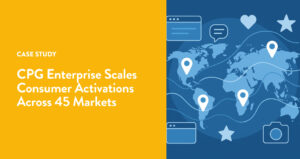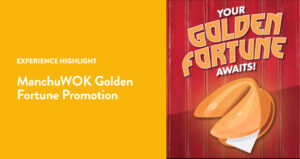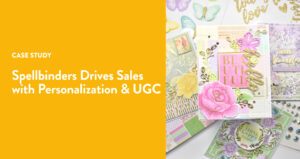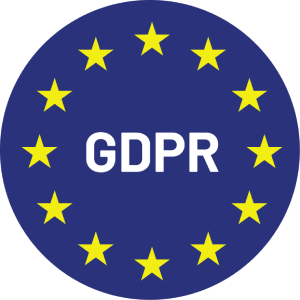After testing Klaviyo and Braze for the last few weeks, we experienced how they perform in real-world scenarios. They each have unique strengths and limitations that make them better for different end users.
Klaviyo is a user-friendly marketing automation powerhouse, ideal for e-commerce businesses. It has an intuitive interface, coupled with integrated customer data, robust personalization options, and AI-assisted segmentation, making it easy for busy marketers to create targeted, data-driven campaigns. Klaviyo’s strength is its simplified approach to crafting essential communication via email, SMS, and push notifications quickly and efficiently.
On the other hand, Braze is a comprehensive customer engagement platform, suited for large enterprises with complex, multi-channel marketing needs. With Campaigns covering most of your communication channels, the Canvas feature offering thorough control over customer journeys, and its extensive global SMS coverage, it provides all the needed flexibility for intricate marketing strategies. Braze caters well to the demands of enterprise-level projects.
However, both Klaviyo and Braze have weak spots when it comes to interactive, gamified content and zero-party data collection and management. That’s why we included Wyng in this comparison, not as an alternative, but as a powerful complement to these platforms.
Wyng specializes in creating engaging digital experiences that provide value to customers as well as businesses. Its exceptional gamification capabilities excel at collecting relevant customer data, which can be utilized to create hyper-personalized campaigns and customer journeys. The Wyng platform has unique strengths in on-site engagement and zero-party data collection that handle the limitations of Klaviyo and Braze, enabling businesses to create relevant marketing communications across all channels.
In this article, we’ll do a deep dive into Klaviyo vs Braze and how Wyng complements them across five key areas:
- Audience Growth & Engagement
- Customer Data Platform Capabilities
- Marketing Automation
- Email Marketing Capabilities
- Mobile Engagement Capabilities
- Analytics and Reporting
Let’s get started!
Klaviyo vs Braze vs Wyng: Comparison Summary
| Klaviyo | Braze | Wyng |
|---|---|---|
 |  |  |
Audience Growth & Engagement | ||
⭐⭐⭐ Form builder with extensive customization options. Limited landing page functionality. Relies on integrations for interactive experiences. User-friendly but lacks advanced engagement features. | ⭐⭐ Limited form capabilities. Landing page feature in development. Offers some interactive elements like Push Stories. More engagement features than Klaviyo, but still limited. | 🏆 Exceptional form builder, landing pages, and interactive experiences. Extensive customization options and templates. Integrates with Klaviyo and Braze to make up for their limitations. |
Customer Data Platform (CDP) Capabilities | ||
🏆 Strong CDP with AI-assisted segmentation. Intuitive interface for data collection, unification, and personalization. Limited zero-party data collection but leverages it well. | ⭐⭐⭐⭐ Flexible segmentation and personalization with Connected Content feature. Recent Data Platform introduction. Limited zero-party data collection capabilities. | 🏆 Excels in zero-party data collection and utilization. Allows building highly customizable data models. Granular segmentation and personalization options. Enriches Klaviyo and Braze’s customer profiles. |
Marketing Automation | ||
⭐⭐⭐⭐ Simplified automation with pre-built templates and AI support. Channel-specific campaigns with A/B testing. Simple but effective for straightforward marketing needs. | 🏆 Complex journey control with the Canvas feature. Multi-channel campaigns with A/B testing. Offers detailed customization for advanced marketing strategies but has a learning curve. | ⭐⭐⭐⭐ Specializes in automating on-site engagement and interactions. Has unique automated features like dynamic questionnaires and targeted pop-ups. Complements Klaviyo’s and Braze’s capabilities. |
Email Marketing Capabilities | ||
🏆 User-friendly email designer with diverse templates. Centralized Deliverability Hub for easy monitoring. Simple but effective for most email marketing needs. | ⭐⭐⭐⭐ Advanced email preview features. Detailed deliverability insights in Deliverability Center. Offers advanced customization but requires more setup. | ⭐⭐⭐ Enhances email relevance through personalized experiences and zero-party data collection. Improves deliverability naturally by building organic lists and increasing engagement. |
Mobile Engagement Capabilities | ||
⭐⭐⭐⭐ Streamlined SMS setup with automatic number assignment. App-based push notifications with customization options. Limited to 12 countries for SMS. Simple but less feature-rich. | 🏆 Extensive global SMS coverage (200+ countries). Diverse mobile engagement options including web push and in-app messages. More complex setup but offers greater flexibility. | ⭐⭐⭐ Enhances mobile campaigns for both Klaviyo and Braze through better data collection and personalization. Offers embedding of interactive experiences in mobile apps. |
Analytics and Reporting | ||
⭐⭐⭐⭐ Easy to use analytics with customizable dashboards. Tailored reports that can be scheduled. Simple out-of-the-box predictive insights. Good for essential analytics needs and straightforward predictions. | 🏆 Specialized analytics tools with channel-specific dashboards. Revenue and Engagement reports. Advanced, customizable predictive models. Suitable for complex analytics and tailored predictions. | 🏆 Powerful Experience analytics and detailed Profiles Metrics. Enhances Klaviyo and Braze's predictions with rich zero-party data. Ideal for in-depth customer experience insights and improving predictive accuracy. |
Best For | ||
Businesses of all sizes seeking simple and intuitive email & SMS marketing automation with powerful CDP. | Large enterprises seeking complex marketing automation across multiple channels with heavy customization needs. | Businesses seeking advanced audience engagement, zero-party data collection, and precise segmentation to complement their marketing efforts. |
What is Klaviyo?
“Data-driven marketing made simple.” 📊🛍️💌
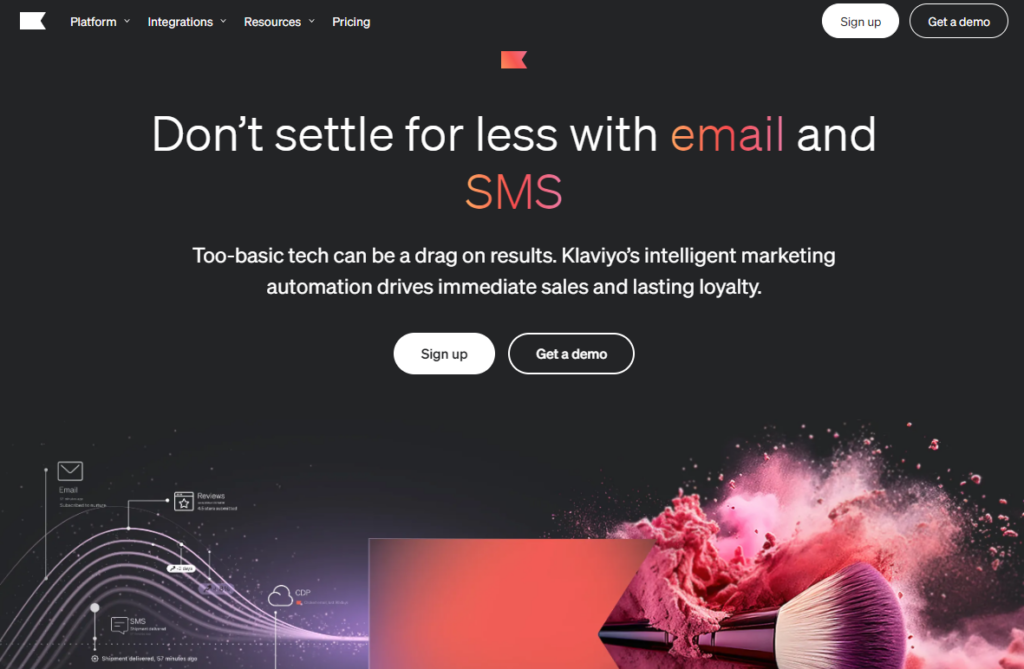
Founded in 2012, Klaviyo emerged from Andrew Bialecki and Ed Hallen’s observation that companies struggled to leverage customer data for personalized marketing. They built an intelligent marketing automation platform to unite data, analytics, and marketing and address a critical data-driven customer engagement gap in the market.
Klaviyo enables real-time data activation for targeted, personalized interactions across email, SMS, mobile push notifications, and user reviews. Its built-in AI, predictive analytics, and industry benchmarks, help guide thought-out marketing strategies. Klaviyo’s integration capabilities and customizable dashboards allow businesses to track key performance indicators and create tailored reports for comprehensive insights into their marketing efforts.
Klaviyo is designed for beginners and businesses of all sizes that want to build stronger digital relationships and increase customer lifetime value through data-driven, personalized marketing strategies.
What is Braze?
“Personalized multi-channel engagement.” 🔥📱💌
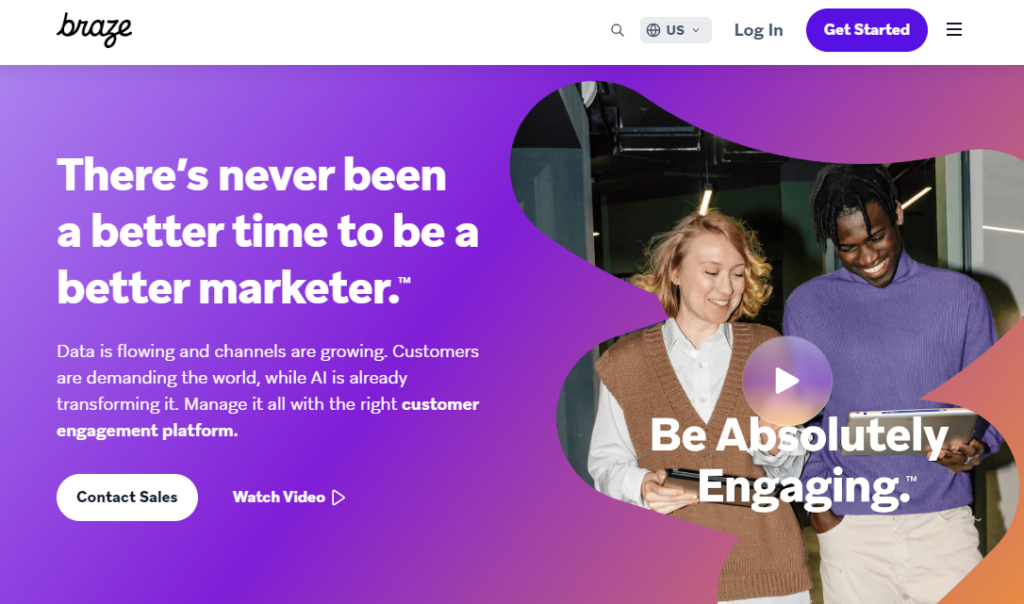
Braze’s CEO Bill Magnuson and CTO Jon Hyman participated in a 2011 hackathon that led to a chance meeting on a Manhattan street corner. They connected with their third cofounder, Mark Ghermezian, and launched Braze to power connections in the moments that matter for brands and consumers.
Braze has evolved into a leading customer engagement platform that delivers relevant, cross-channel experiences at scale. Its standout features include the Canvas feature for building complex, multi-channel user journeys and the Campaigns feature enabling communications via numerous channels. Braze offers robust mobile engagement options, including push notifications, in-app messages, and WhatsApp, alongside extensive SMS marketing capabilities supporting over 200 countries.
Braze is ideal for enterprises seeking to forge deeper connections with their customers. It’s particularly suited for companies looking to build a strong mobile presence and leverage data-driven, personalized marketing strategies across multiple channels.
What is Wyng?
“Interactive Experiences that fuel zero-party data collection.” 🚀🎯📈
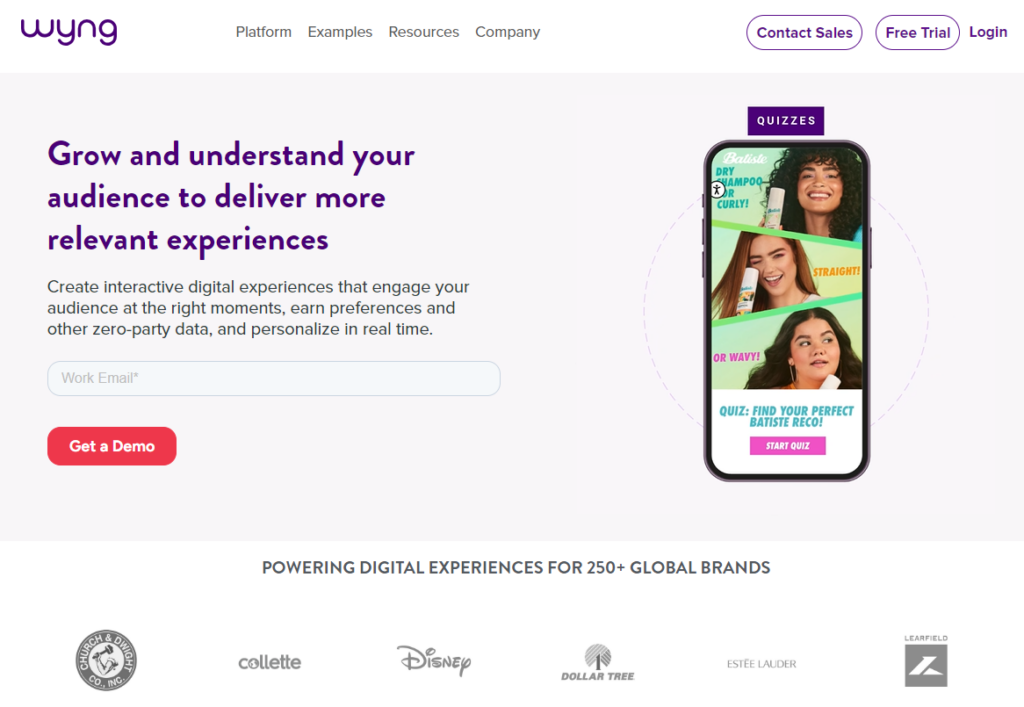
Founded in 2010 by Wendell Lansford and Prakash Mishra, Wyng emerged from a desire to revolutionize marketing strategies by prioritizing consumer experiences. The founders, frustrated with traditional marketing approaches, set out to create a platform to help brands achieve their goals while delivering exceptional digital experiences.
The Wyng platform enables marketers to build personalized, interactive Experiences that engage customers while collecting crucial zero-party data, which can be utilized to make precise audience segments. The Wyng Experience Studio allows you to build gamified interactions like product finder quizzes, spin-to-win promotions, UGC galleries, and preference centers, all designed to be valuable to consumers as well as businesses. The platform also offers powerful analytics through Wyng Metrics, providing insights into audience engagement, form submissions, user-generated content performance, and more. Its unique approach to customer engagement also builds up the marketing capabilities of automation platforms like Klaviyo and Braze.
Today, Wyng serves over 250 global brands, including industry giants like Disney, Estée Lauder, and Unilever. It’s ideal for marketers seeking for advanced audience engagement, zero-party data collection, and precise segmentation to complement their marketing efforts through engaging digital experiences.
Klaviyo vs Braze vs Wyng: Audience Growth & Engagement
Wyng enhances Klaviyo and Braze’s basic features with advanced form building, landing pages, and interactive experiences, that take your audience engagement to the next level.
| Klaviyo | Braze | Wyng |
|---|---|---|
⭐⭐⭐ | ⭐⭐ | ⭐⭐⭐⭐⭐ |
Form Builders: Klaviyo has a form builder with extensive customization options, Braze has limited form functionality, and Wyng allows endless advanced fields.
Klaviyo‘s custom form builder is useful for diverse, mobile-friendly sign-up forms and announcements. It supports:
- Multi-step forms
- Full-page forms
- Banner forms
- Popup forms
- Flyout forms
- Embed forms
The drag-and-drop interface allows you to customize every visual element, from form fields to branding elements and, if you’re unsure how to build them yourself, Klaviyo offers over 70 form templates.
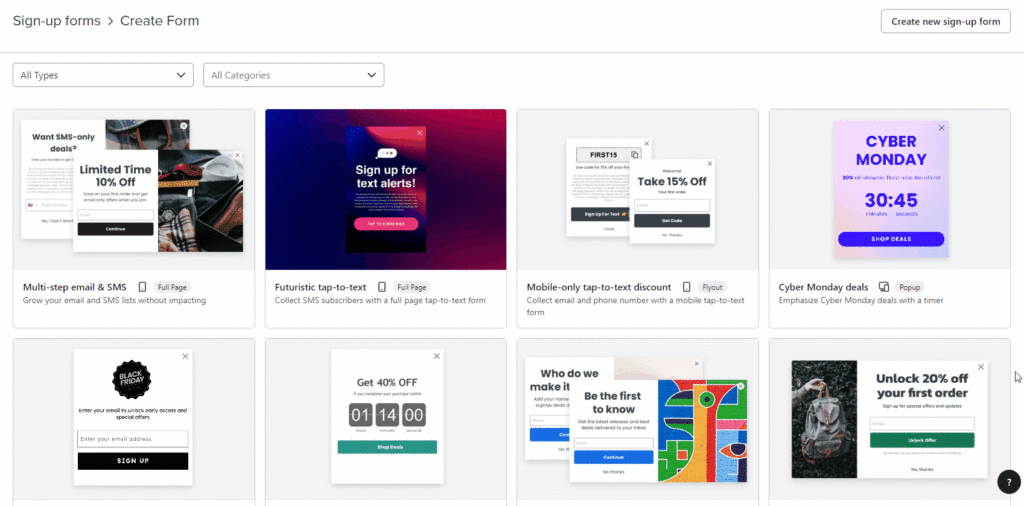
You can also fine-tune when and where each form appears on your site or use “smart targeting” to show or hide specific forms to all visitors or only certain segments (e.g., first-time visitors).
For optimization, Klaviyo supports form A/B testing to experiment with different text, colors, and locations to identify the best-performing variations.
Braze, on the other hand, lacks a dedicated form-building feature. Instead, it offers form functionality through web and mobile in-app messages. This approach allows for:
- Simple surveys
- Email sign-up forms
- SMS and WhatsApp sign-up forms
It offers two in-app message editors: a drag-and-drop editor and a traditional editor.
Within the traditional editor, you can create a simple survey. It allows you to set up a first message page with text and single-choice or multiple-choice questions and a confirmation page with thank you text and a button. However, customization options in the traditional editor are limited. You’re restricted to choosing a single-color theme without additional visual tweaks.
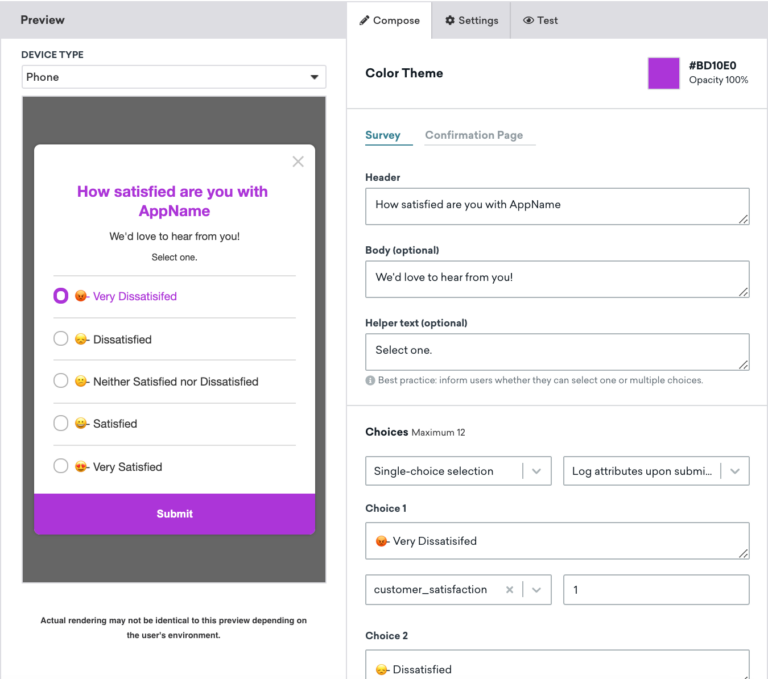
Source: Braze
Within the drag-and-drop editor, you can create email, SMS, and WhatsApp sign-up forms. This editor offers more customization options — you can modify message components, fonts, link colors, and more, up to your liking.
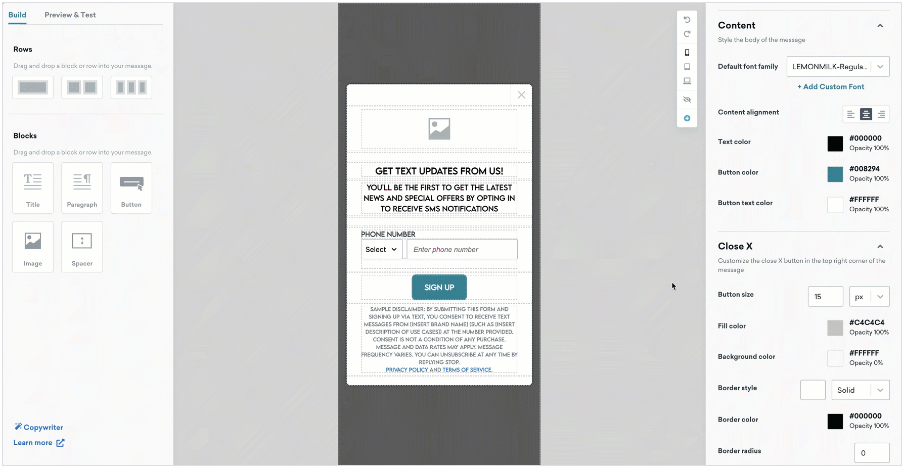
Source: Braze
While Braze’s native form capabilities are limited compared to Klaviyo’s, Klaviyo doesn’t exactly shine in this area either. Both tools, however, integrate with Wyng.
The Wyng Experience Studio, a drag-and-drop builder, allows you to build all sorts of interactive Experiences that go way beyond your standard forms. But more on Experiences later.
In the Experience Studio, you can find the Form component, which you can drag into any Experience you create. With the Form component itself, you get a large list of field options, allowing you to create web forms that capture exactly the data you need. Need to add opt-in and consent fields? You can add as many as necessary, helping you stay compliant with data regulations. You can also verify data quality before collection, ensuring you get usable phone numbers and zip codes, for example.
Wyng also offers a unique image field that lets participants select photos directly from their galleries. This feature is perfect for receipt uploads or UGC campaigns.
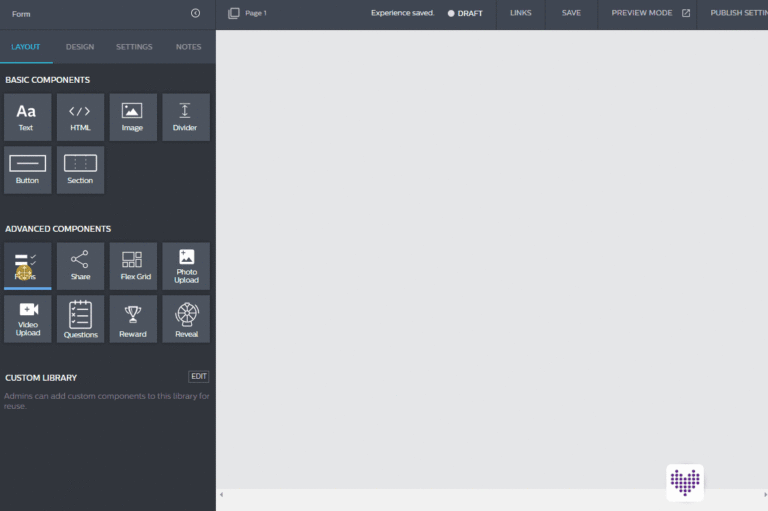
If you want to run promotions, you can set participation limits, generate unique referral codes, and track sharing. And for any exclusive content, you can require form submission to reveal hidden elements. You can also validate product UPC codes or single-use codes as a participation gate.
These features will help you increase both the quality and quantity of leads, giving you powerful tools to create engaging, effective forms for various marketing needs. By integrating Wyng with Klaviyo or Braze, you can leverage Wyng for advanced form capabilities to capture high-quality data and then feed that data into your chosen marketing automation platform for precisely targeted campaigns.
So if you’re looking to level up your customer engagement and data collection, give Wyng a try — book a demo here!
Landing Pages: Klaviyo has a workaround, Braze's dedicated feature seems to be still in development, and with Wyng every Experience can be a landing page.
Klaviyo doesn’t provide a dedicated landing page builder, but it offers an alternative.
You can create something resembling a landing page using a full-page sign-up form. It allows some customization like adding various element blocks and input blocks to structure your content and choose backgrounds, images, colors, and fonts.
It’s not exactly a landing page but works as one if you just need to capture information.
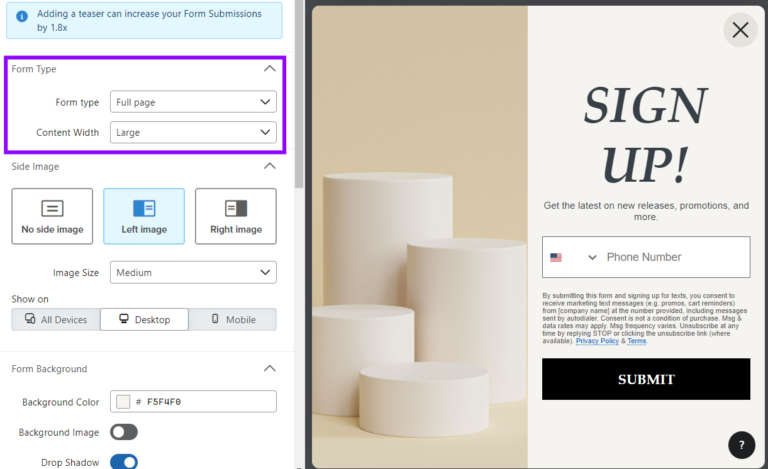
As of writing this, Braze has announced an upcoming product for landing pages in October 2023. So far, there’s no specific information on it though and you still need to rely on integrations.
Meanwhile, Wyng sure takes the cake here.
You can publish every single Experience you build in the Experience Studio directly as a landing page, complete with custom URLs and meta tags for SEO. Apart from customizing the URL, you can also host your Experiences on a custom subdomain that fits your brand. So instead of “app.wyng.com/landing-page“ it can be “your-brand.wyng.com/landing-page”.
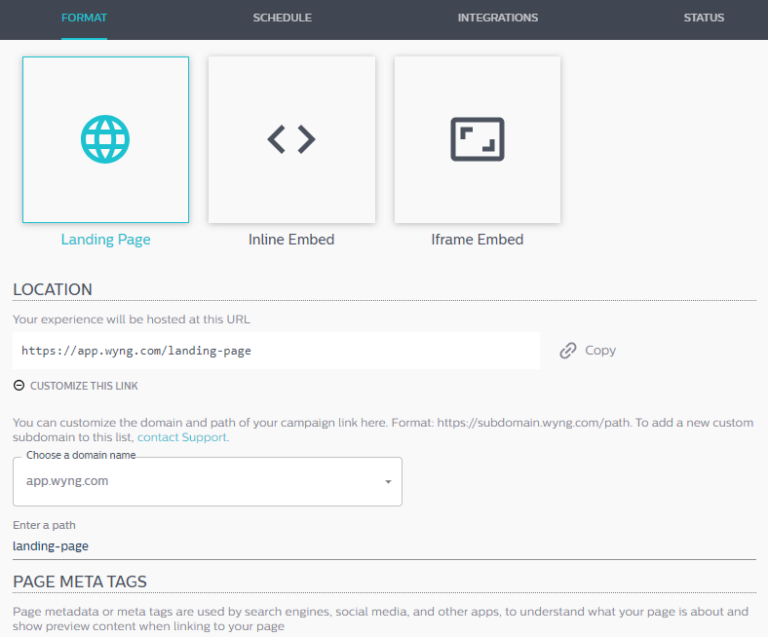
And, you can even turn it into a sales page. If you create a UGC feed on your Experience page, you can assign your products to every piece of content. Simply assign a conversion unit — a product — to a piece of content relevant to that product. Your product is tagged and leads directly to your store. And there you have it, a shoppable UGC experience.
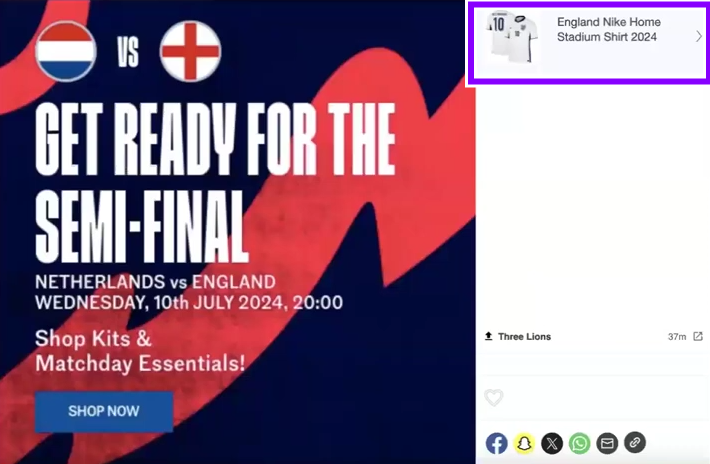
All being said, Wyng isn’t a replacement for Klaviyo or Braze. In this sense, it works best as an extension of their multichannel marketing capabilities. If you want an engaging landing page to use in your email or SMS campaigns, you could build that landing page in Wyng and link to it. Best of both worlds!
Learn more about how Wyng works with Klaviyo or Braze — book a demo here!
Interactive Experiences & Gamification: Braze offers some interactive experiences, Klaviyo relies on integrations, and Wyng has all the gamification features you need.
Klaviyo keeps it simple when it comes to interactive experiences and gamification.
You won’t find many built-in features, except for two-way messaging. If you’re looking to spice up your visitors’ digital experiences with interactive, engaging, and fun content, we encourage you to try Wyng!
Braze, on the other hand, gives you more to work with right out of the gate.
Like Klaviyo, you get two-way SMS messaging but Braze takes it further with Push Stories. This feature lets you embed carousel-like interactive image galleries in individual push notifications and add buttons to engage your audience.
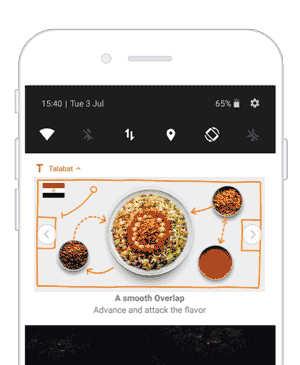
Source: Braze
Braze also supports AMP (Accelerated Mobile Pages) for Email. This means you can send rich, dynamic content your users can interact with in their desktop or mobile inbox. But there’s a catch. You’ll need some help from developers to build and deploy a complete interactive experience with AMP. It’s not exactly a plug-and-play solution.
When it comes to gamification, neither platform makes it a walk in the park. You need to rely on integrations or coding to implement gamification features in both. And don’t expect any ready-made templates or automations specifically for gamification.
This is where Wyng shines.
In the Wyng Experience Studio, you can start building interactive Experiences from a blank space or by choosing a pre-built template in a huge library. Each template can be found in a category, tailored to a specific use case:
- Collect Preferences & Zero-Party Data
- Progressive Data Capture
- Recommend Products & Content
- Sweeps & Promos
- Gamification & Instant Win
- Quizzes & Surveys
- Social & UGC
- Coupons & Samples
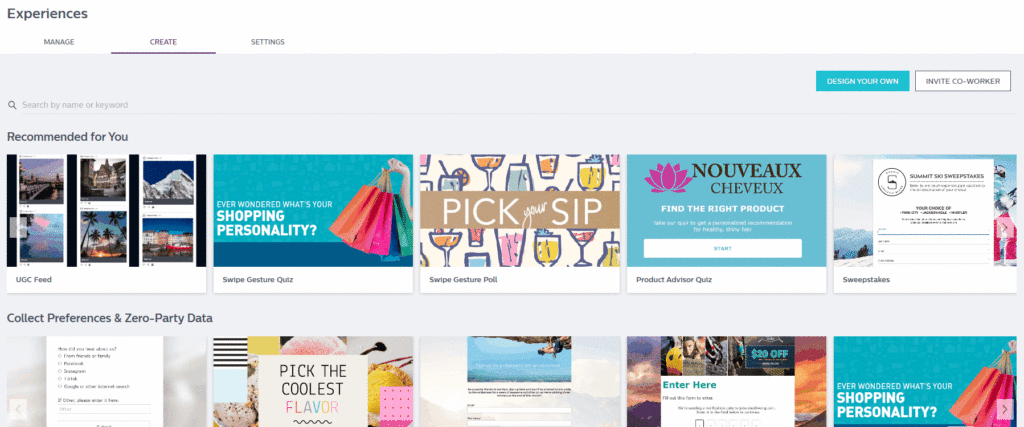
No matter which template you start with, you have the freedom to completely customize it. And not just colors, fonts, and images.
Want to turn that quiz template into an interactive contest with a spin-to-win wheel? Or maybe you’d like to add product recommendations and shoppable elements? Wyng allows you to do that. It has highly specific components that other builders don’t. To every single Experience, you can add forms, photo upload fields, video upload fields, flex grids showing collections of UGC, social media links, questions, rewards, and reveals with spin-to-win wheels, scratch-offs, and more.
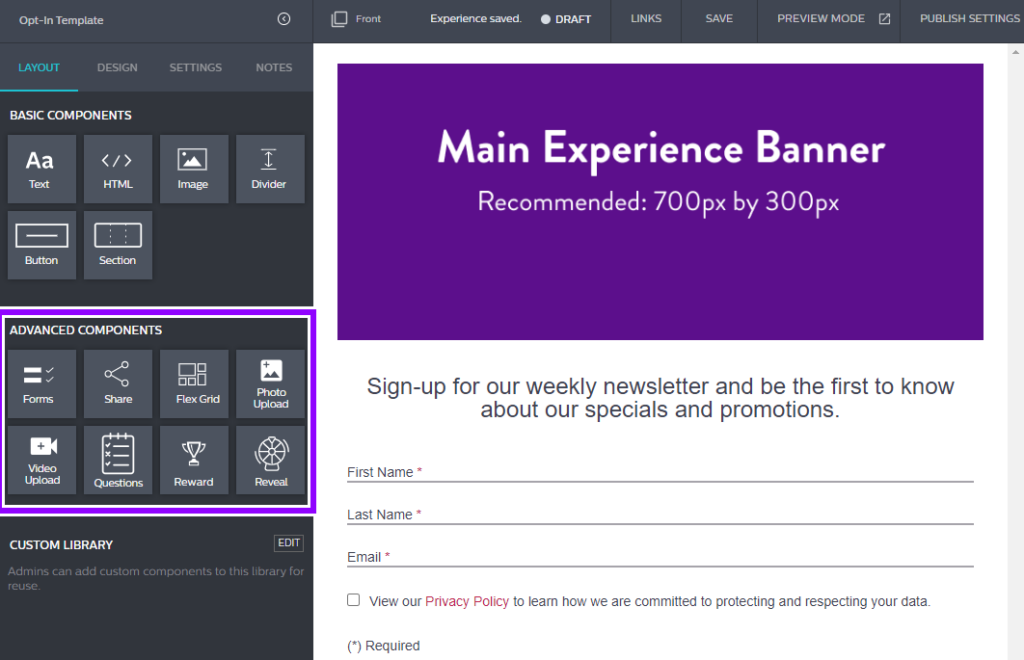
You have the flexibility to distribute Experiences however you want. Whether you want to embed your Wyng Experiences directly on your site, share them as standalone landing pages, or even display them in-app, Wyng makes it possible.
And you don’t need a team of developers to bring these experiences to life. They are ready to go in Wyng.
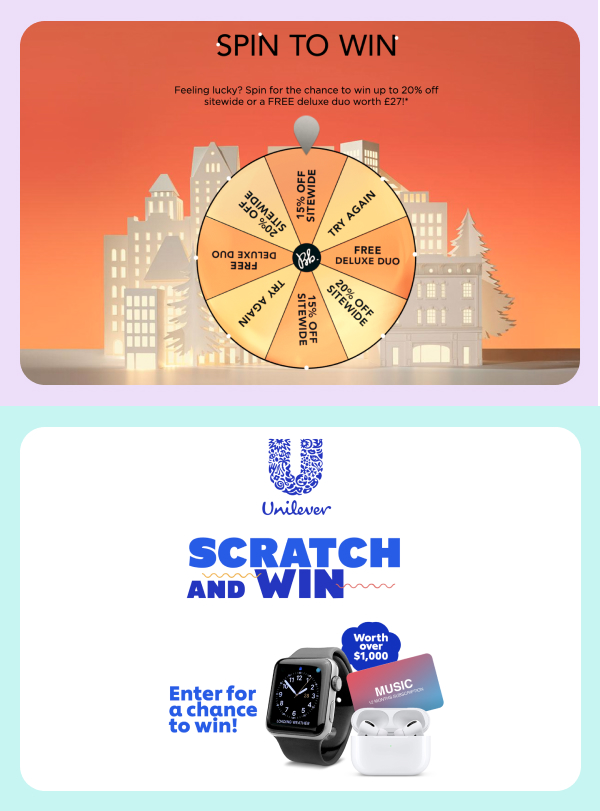
But Wyng isn’t just about on-screen gamification.
It also supports robust UGC functionality. You can build contests via Instagram Reels, photo/video uploads, and social media galleries that get your customers excited to participate and share your brand.
Your visitors get to play and they’re even rewarded for it with single-use coupons, multi-use coupons, free samples, or something else you want to offer. You, on the other hand, get their zero-party data without prying and with full consent.
If you funnel that rich zero-party data directly into Klaviyo or Braze you’ll see your lead database growing and your customer profiles improving. What’s more, if you complement your email and SMS campaigns with links to Experiences, the engagement rates will increase as well.
Learn how to make your customer experience better with Wyng — book a demo here!
Verdict: Wyng outshines Klaviyo and Braze in form building, landing pages, and interactive experiences, offering advanced features and customization. Importantly, Wyng integrates with both platforms to improve their native capabilities and provide a comprehensive solution for creating engaging customer experiences across all channels.
Klaviyo vs Braze vs Wyng: Customer Data Platform (CDP) Capabilities
Klaviyo excels in CDP and AI-assisted segmentation, Braze offers high flexibility in building segments and personalization, and Wyng specializes in zero-party data collection, detailed segmentation, and intricate customer profiles, enhancing both platforms’ capabilities.
| Klaviyo | Braze | Wyng |
|---|---|---|
⭐⭐⭐⭐⭐ | ⭐⭐⭐⭐ | ⭐⭐⭐⭐⭐ |
Data Collection & Unification: Braze and Klaviyo offer granular customer insights and Wyng enriches them with zero-party data.
Klaviyo‘s Customer Data Platform (CDP) is purpose-built for marketers, offering an intuitive interface with pre-built starting points. Using it, you can quickly uncover insights about your products, customers, and performance to power personalization across channels.
What sets Klaviyo apart is its unique OLAP + OLTP composite data store.
This allows you to store unaggregated lifetime event data for all your customers, giving you a true 360-degree view of each customer’s history with your brand.
Overall, Klaviyo’s CDP features are split into two main groups:
- Intelligence components for reporting needs (like funnel analysis, RFM, customizable CLV, and audience performance).
- Data management components for getting data in and out of Klaviyo (let you set up data warehouse syncs, webhooks, and custom code functions).
And, even without the CDP, you can still do basic onsite tracking because Klaviyo automatically tracks user interactions with your messaging channels and builds unified user profiles.
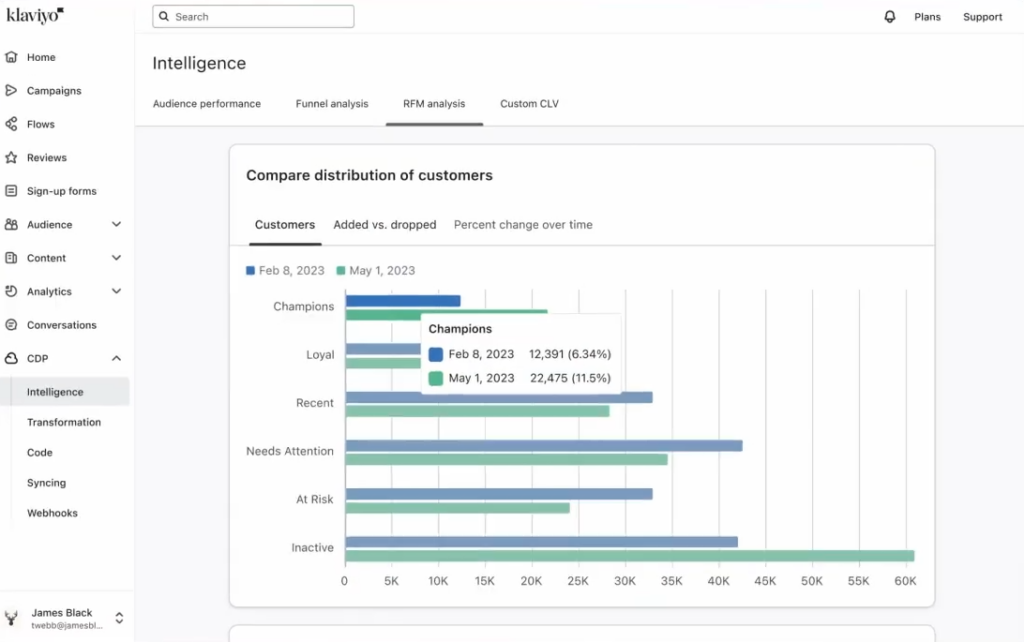
Source: Klaviyo
Meanwhile, Braze just recently introduced the Braze Data Platform.
While not strictly a CDP, it helps marketers and technical teams integrate Braze with other tech, derive insights, and take action across the data lifecycle.
The data Platform unifies data with bi-directional flows between Braze and your data warehouse, CDP, digital properties, backend systems, and other software. It then takes this data and creates customer profiles to fuel personalized experiences.
But you don’t need the Braze Data Platform for basic analytics.
Once you integrate the Braze SDK with your app or site, it automatically collects certain data including user interaction and demographic metrics. That’s enough for both analytics and user profile building.
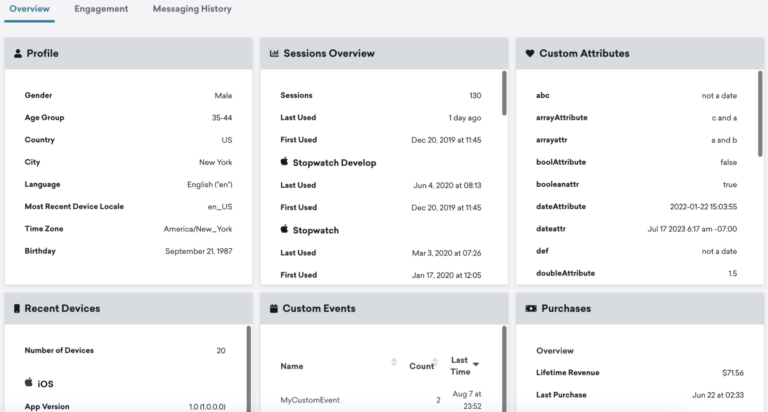
Source: Braze
Wyng, on the other hand, is a powerful complement to the customer data platforms of Klaviyo and Braze, but it also works data magic on its own.
While Braze and Klaviyo do collect some data on user characteristics to build customer profiles, they focus more on tracking event data. The customer attributes collected are pre-defined and if you want to collect custom ones, it will require some legwork.
Now, you might be thinking, “But I already get customer data through Klaviyo or Braze, why do I need Wyng too?” The difference is in the depth and specificity of the data.
With Wyng Profiles you get to collect and unify customer data on a personal level.
The customers get to control what data they share and you get to control what you collect. You can create fully customizable data models because you have full control over the data attributes you collect in Experiences. Attributes are defined by you. Want to know your customers’ favorite colors, hobbies, or dream vacation destinations? Just build those data points into your Wyng Experiences.
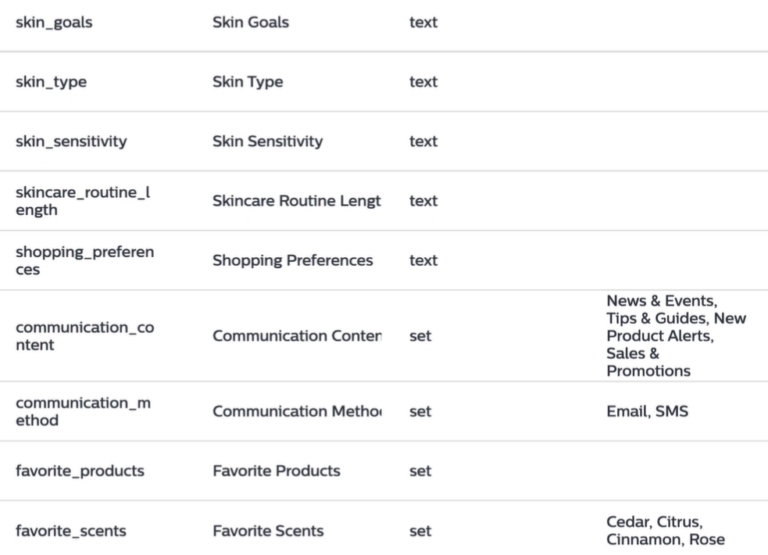
Since Wyng naturally collects data before a user is recognized, anonymous users get a profile, too. This allows privacy-first personalization even for unknown visitors. Once a form is filled in with a unique identifier, data from across multiple anonymous sessions can be aggregated into a single customer profile.
Also, with Wyng your customer data never becomes irrelevant as your customers’ preferences change over time. With each data attribute, you can set relevance and retention windows, which are both unique values to zero-party data collection.
You can sync data models built in Wyng to Klaviyo or Braze and craft extremely relevant campaigns from there. You get to do better marketing campaigns and lower your customer acquisition costs, just because you have better data.
Learn how Wyng Profiles work in real-life scenarios — sign up for a demo here!
Audience Segmentation: Klaviyo makes segment building easy, Braze allows more complex options, and Wyng lets you segment users with unique attributes.
With Klaviyo, you get a segmentation powerhouse that does half the work for you.
Their Segments AI feature is like having a marketing assistant who understands exactly what you’re looking for. You just describe the segment in plain English, and the AI sets it up.
But don’t worry if you prefer a hands-on approach. Klaviyo lets you build segments manually with up to 100 conditions per segment. You can mix and match based on customer actions, custom properties, location, GDPR consent, list membership, marketing preferences, and even predictive analytics.
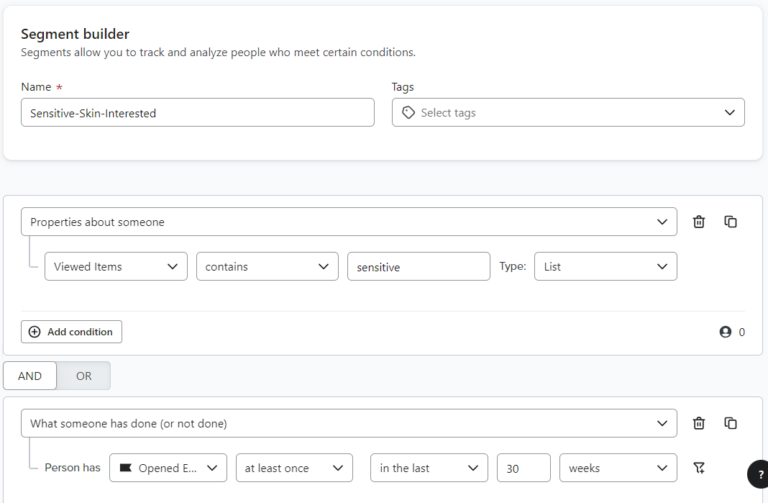
And with AND/OR logic joining your conditions, you can get as specific as you need.
For further refinement, you can add filters to your actions. This level of precision means you can create highly targeted lookalike audiences for your social media campaigns, saving money on ad spend.
Braze takes a different approach to segmentation.
It doesn’t offer AI assistance but gives you more flexibility in building segments. It includes over 100 out-of-the-box filters and you’re not limited to predefined conditions. This means you can get even more specific with your segments but need to learn how to build them and know the specific features and attributes you’re looking for.
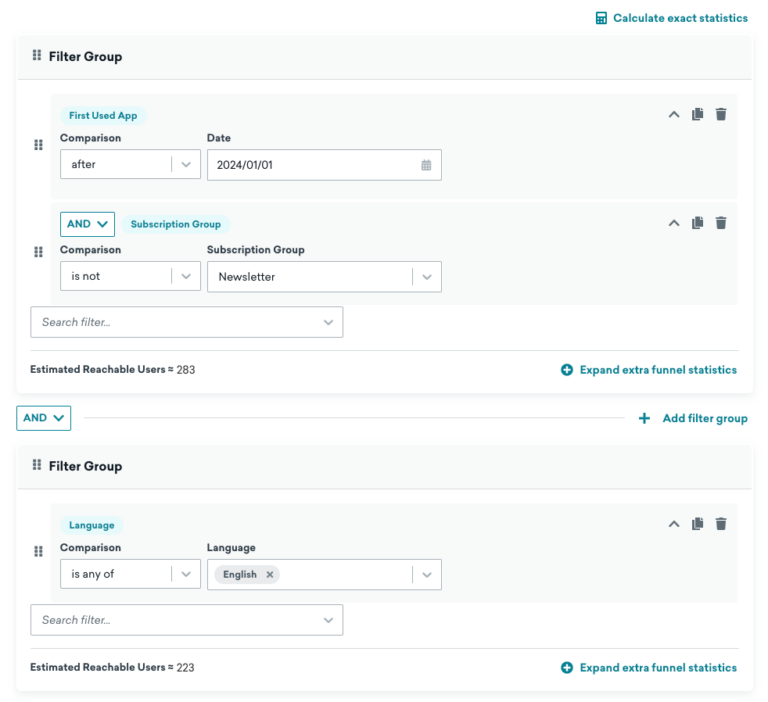
Source: Braze
One nice touch in Braze is the real-time statistics you see while building your segment. You can instantly see how many users you can reach through different channels, helping you evaluate the potential impact of your campaigns on the fly.
Wyng will help you make your segments even more insightful and targeted.
When someone interacts with one of your Wyng Experiences, a user profile is automatically created under the People tab within the Profiles features. From there, you can slice and dice your audience into highly targeted Segments.

For example, let’s say you’ve created a skin type quiz in Wyng. You can then separate users into segments for dry, oily, or combination skin, and funnel these lists directly into Klaviyo or Braze. This again allows you to deliver personalized content and offers that are truly relevant to each individual.
And as customers further interact with your Wyng Experiences over time, Wyng Profiles get richer with valuable preference data. Those data attributes can be used (and overlaid) with one another to create even more specific Wyng Segments.
Ready to take your audience segments to the next level with Wyng? Book a demo here!
Audience Personalization: Klaviyo wins with its Product Feed block, Braze wins with its Connected Content feature, and Wyng wins with hyper-personalization capabilities for its own Experiences as well as Klaviyo’s and Braze’s.
When it comes to personalization, both Klaviyo and Braze do a great job.
With Klaviyo, you get a complete profile for each customer, showing their history, engagement, and activity with your company. You can even predict future customer behavior.
Pulling information directly from customer profiles, Klaviyo allows you to personalize your communication in many different ways. By using dynamic fields in text, you can address each customer directly. For example, a dynamic field tag for First Name will automatically get replaced with an actual first name taken from a customer profile.
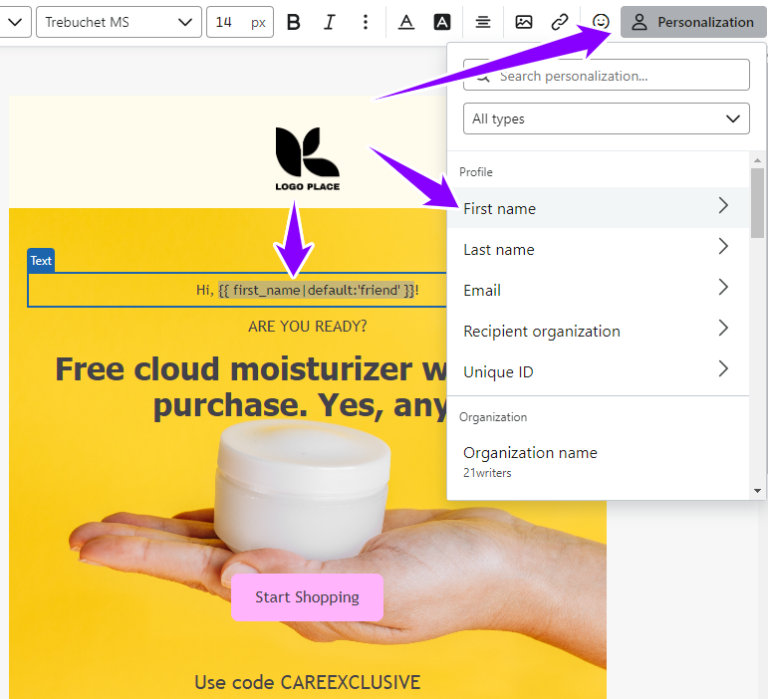
Then you can add a Product Feed block into your emails, which lets you quickly showcase personalized product recommendations based on your integration with one of the ecommerce platforms. You can choose which products your customers see, such as best-sellers, newest items, or products they’ve recently viewed or added to their cart.
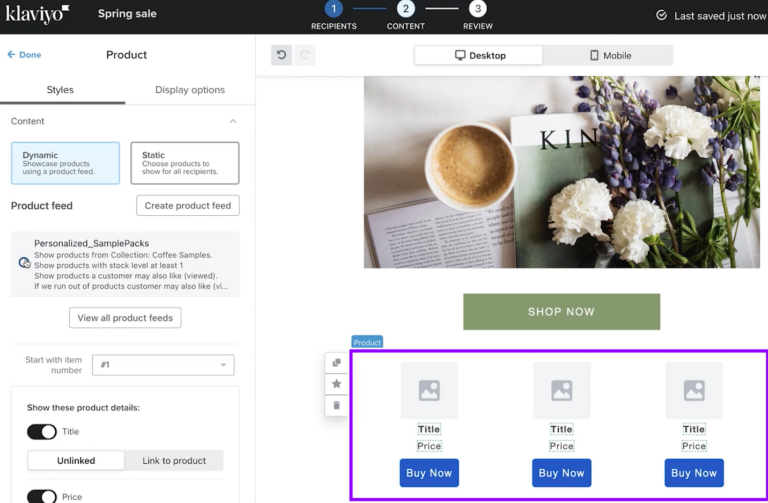
Source: Klaviyo
Another way of dynamically adapting content is that for each element in your email, you can set up conditional logic to determine whether a person sees specific content or not. Messaging different content to different segments also ensures that each contact is tailored to the customer’s interests, behaviors, and actions.
Braze matches Klaviyo’s personalization capabilities.
Like Klaviyo, you can use unified user profiles and segmentation to create highly personalized messages. Braze uses Liquid tags, which work similarly to Klaviyo’s dynamic fields, inserting user-specific information into your messages.
Braze also supports product recommendation in your messaging, which can be used by adding a Liquid tag for Item Recommendation. It allows for more specific recommendations based on filters like the best rating on product reviews, loyalty programs, and more. But be prepared for some legwork — there’s an extensive guide you’ll need to follow to set it up properly.

Source: Braze
But here’s where Braze pulls ahead: their Connected Content feature.
This allows you to insert any information accessible via API directly into your messages and allows for hyper-personalization, like sending an email with a personalized weather forecast for each recipient.
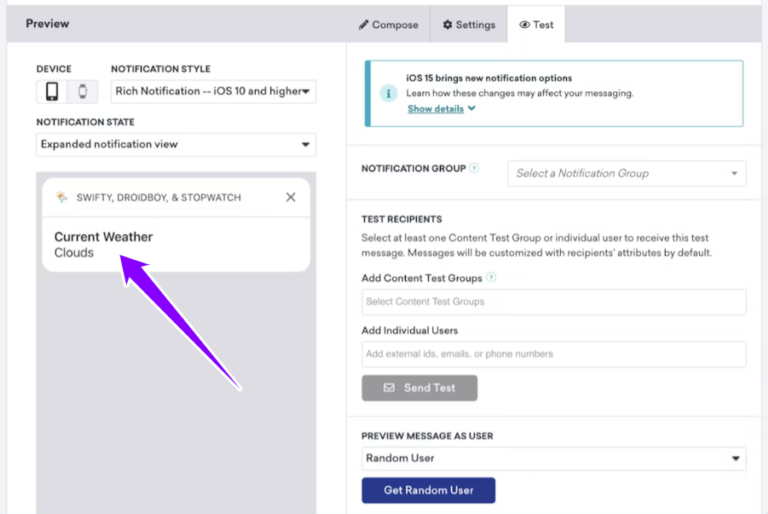
Source: Braze
Wyng also has some incredible personalization capabilities.
Using Wyng Segments, you can fully personalize content within Experiences. For example, the content can change based on whether it’s a woman looking for sensitive skin care products or a man looking for shaving products. Within a UGC display, these two customers can see completely different content. You can skip or change certain questions in quizzes — a single traveler gets a different set of questions than a family traveler. And in the spin-to-win Experience, you can offer way more fitting rewards rather than generic ones — reward new users with a sample or reward existing customers with loyalty points.
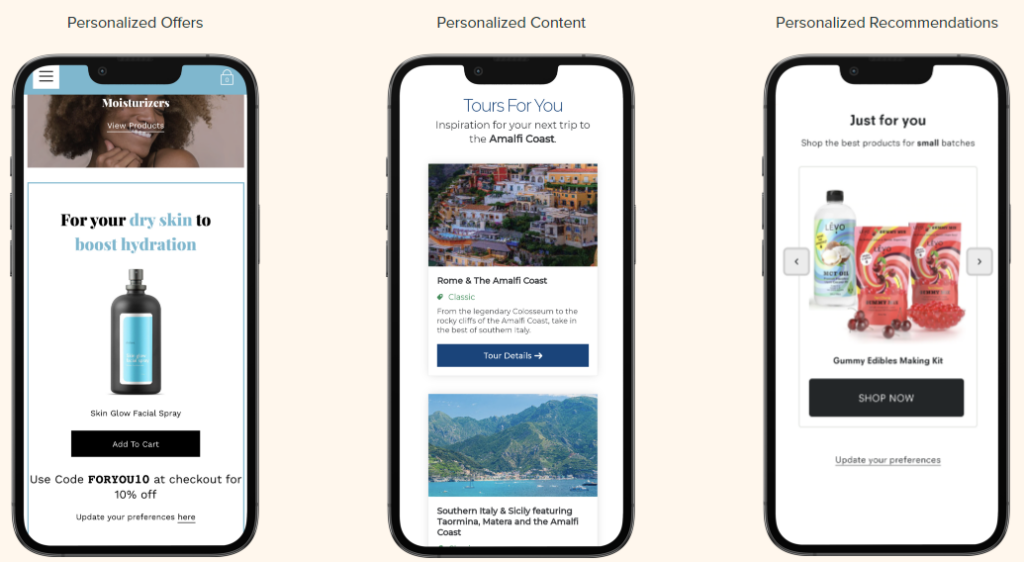
Wyng offers open APIs and SDKs for Experiences and Profiles, with similar functionality to Braze’s Connected Content. You can pull data with API calls from another website and show personalized content like different product recommendations based on zip code.
You can even activate Wyng Segments in external systems like ESPs or advertising platforms by exporting a list of users or using one of the productized integrations. So Wyng helps you out with personalization in Klaviyo and Braze as well. Your customer profiles, where you take information from for personalized messaging, get far more detailed with Wyng.
This is how Wyng supports product recommendations in Braze and Klaviyo as well.
Simply ask about favorite fragrances or preferred communication channels with the Wyng Preference Center Experience, then use this data to enhance Klaviyo’s Product Feed or Braze’s Liquid tags.
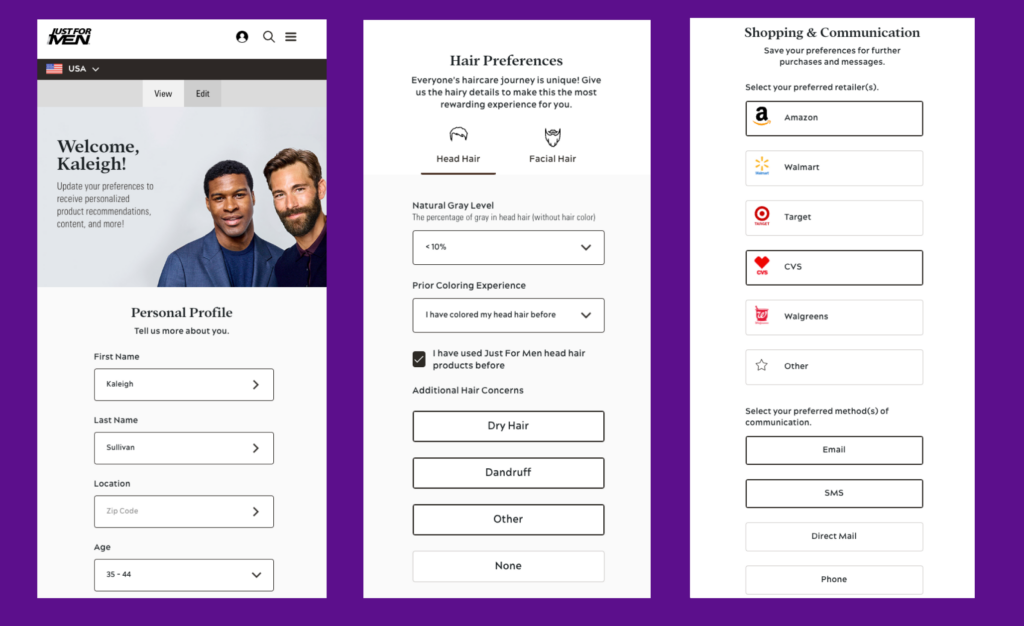
Zero-Party Data Utilization: Klaviyo and Braze both leverage zero-party data, but Wyng collects it best.
Klaviyo takes a “customer-first” approach to data, combining zero-party data (information customers voluntarily provide) with first-party data (information observed from customer interactions on your properties).
To collect zero-party data, Klaviyo provides built-in sign-up forms. While these forms aren’t the most engaging, they get the job done. As soon as a customer submits information, it’s instantly stored in Klaviyo’s built-in database. This data is then allocated to individual customer profiles for precise segmentation.
Braze, on the other hand, has limited dedicated forms for zero-party data collection but still puts zero-party data to good use. Any data you collect is allocated to unified customer profiles, enabling precise segmentation and personalization options.
While both platforms work better with zero-party data neither of them is good at collecting it. But you can leave that job to Wyng!
With Wyng, you can create engaging digital experiences that encourage your customers to willingly share information about their likes/dislikes, values, interests, and needs. You can then integrate this collected zero-party data with Klaviyo and Braze, where you can make the most use of it.
Verdict: Wyng is the winner for its superior zero-party data collection and segmentation capabilities. While Klaviyo and Braze have strong features for that, Wyng complements both platforms by enriching customer profiles with unique, user-provided attributes, enabling more targeted marketing campaigns and personalized experiences across all three tools.
Klaviyo vs Braze vs Wyng: Marketing Automation
Klaviyo excels in user-friendly automation, Braze offers complex journey control, while Wyng specializes in on-site engagement, complementing the others’ multichannel capabilities.
| Klaviyo | Braze | Wyng |
|---|---|---|
⭐⭐⭐⭐ | ⭐⭐⭐⭐⭐ | ⭐⭐⭐⭐ |
Automated Workflows: Klaviyo's Flows offers ease of use with pre-built templates and AI support, Braze's Canvas provides detailed control and complex journey design, and Wyng has its own unique automation workflows.
Klaviyo‘s automated workflow feature, called Flows, is seamlessly integrated with Klaviyo’s built-in database and marketing channels — allowing you to create personalized, multi-channel messaging campaigns with ease.
Getting started with Flows is straightforward. You can choose from over 60 pre-built, customizable flow templates or let Flows AI do the heavy lifting. If you prefer a hands-on approach, you can build flows from scratch using the drag-and-drop builder.
The builder uses a tree-like structure, guiding you step-by-step from a trigger forward. You’ll set up flows based on known user behaviors such as viewing a product, starting a checkout, placing an order, or filling out a form. This approach makes it easy to visualize and understand your customer journey.
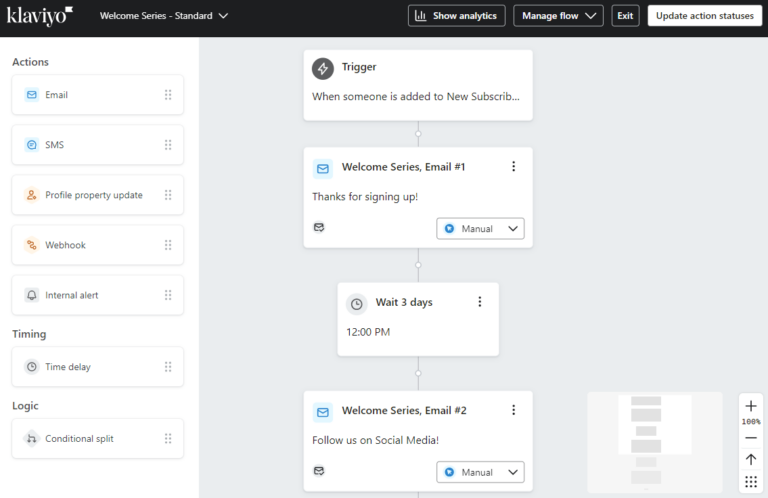
To fine-tune your messaging, you can use branching conditions or “split logic” within your flows. This allows you to create more relevant responses based on factors like cart value, customer type (new vs. returning), location, or customer lifetime value. As a result, different audience segments receive tailored messages that resonate with their specific situation.
One standout feature in Klaviyo’s Flows is the ability to use webhooks. You can instantly send information about a customer action to an external platform, triggering processes outside of Klaviyo. For example, you could automatically send a gift card when a customer mentions your brand on social media.
For testing Klaviyo also allows you to A/B test flow branches using the conditional split component to test things like timing, discounts, and number of emails within a flow.
Braze takes a more structured approach to automated workflows with its Canvas feature.
Here, you’ll build automated user journeys that connect multiple communication channels, triggered by various events and behaviors. Before diving into Canvas creation, Braze requires you to set up several parameters. You’ll need to:
- Assign one or more conversion events to track for this specific Canvas.
- Choose how users enter the Canvas (at a set time, based on user actions, or triggered by API).
- Define the audience for this Canvas and set exit criteria.
- Configure send settings.
While this initial setup might seem more involved compared to Klaviyo’s approach, it gives you precise control over your automated workflow from the outset.
The Canvas builder itself uses a drag-and-drop interface but with a unique twist. Instead of connecting elements directly, you’ll place components on a grid and then create connections separately. This gives you more freedom in designing complex, non-linear journeys compared to Klaviyo’s more structured approach.
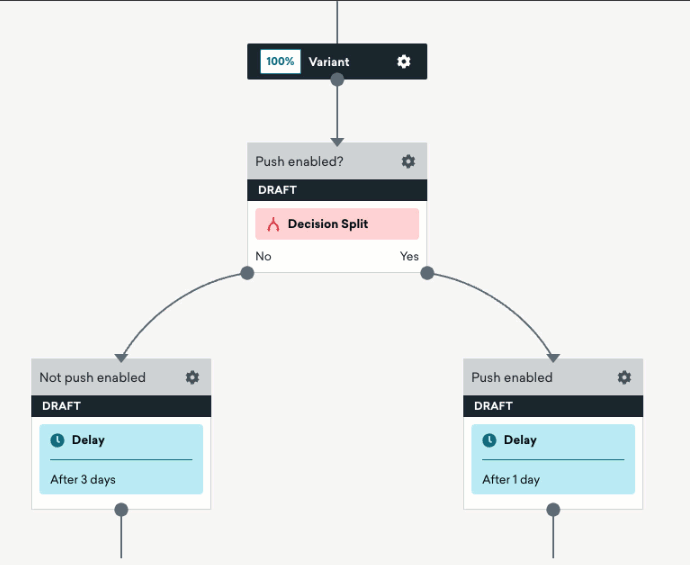
Source: Braze
Like Klaviyo, Braze allows you to add decision splits to your Canvas, similar to Klaviyo’s trigger and conditional splits but Braze also offers an interesting feature: the Experiment component. This allows you to test different paths within your Canvas, sending one group down one route and another down a different one. You can then compare performance to optimize your automated workflows over time.
Wyng isn’t a direct competitor to Klaviyo or Braze in terms of marketing automation. Instead, it’s a powerful tool that complements their automation workflows by improving the quality and depth of your customer data.
It does have some automation features of its own, however. The Moments feature deploys targeted pop-ups or embedded experiences across your site, triggered by specific user behaviors, attributes, or URL patterns. This ensures you’re presenting the right experience to the right person at the right time.
And then there’s the Wyng Visual Flow Builder, which takes personalization further with dynamic questionnaires that adapt based on visitor responses. Its advanced branching logic allows you to create product recommendation quizzes or other interactive experiences that drill down to truly relevant suggestions.
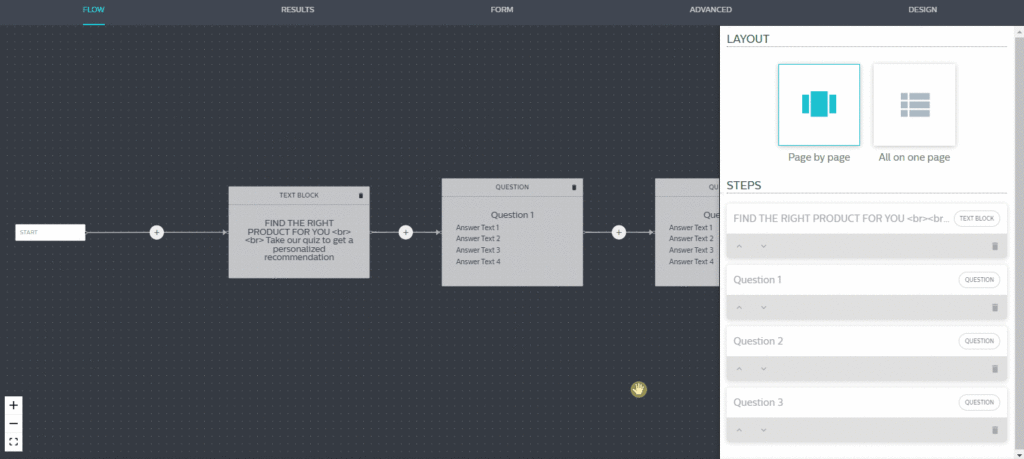
Campaigns: Klaviyo's Campaigns are channel-specific, Braze has both multi-channel and single campaigns, and Wyng specializes in on-site interactions.
Klaviyo lets you create broadcast messages through email, SMS, and push notifications.
Its Campaigns are perfect for one-time messaging about product launches, sales announcements, and newsletters about your business, while, if you’re looking for trigger-based campaigns, you’ll want to use its Flows feature instead.
With Klaviyo, you’ll need to choose a specific channel for each campaign. This approach keeps things simple, but it means you have to set up separate campaigns to reach customers across multiple channels.
You can also A/B test Campaigns.
You’ll find the “Create A/B test” option in the setup window. There are two options: test content variations or send times (content is the same across variations). You can test multiple variants, but Klaviyo recommends sticking to two for a more straightforward analysis. Next, choose your winning metric from open rate, click rate, or placed order rate. You can also decide what percentage of your audience will receive each variant.
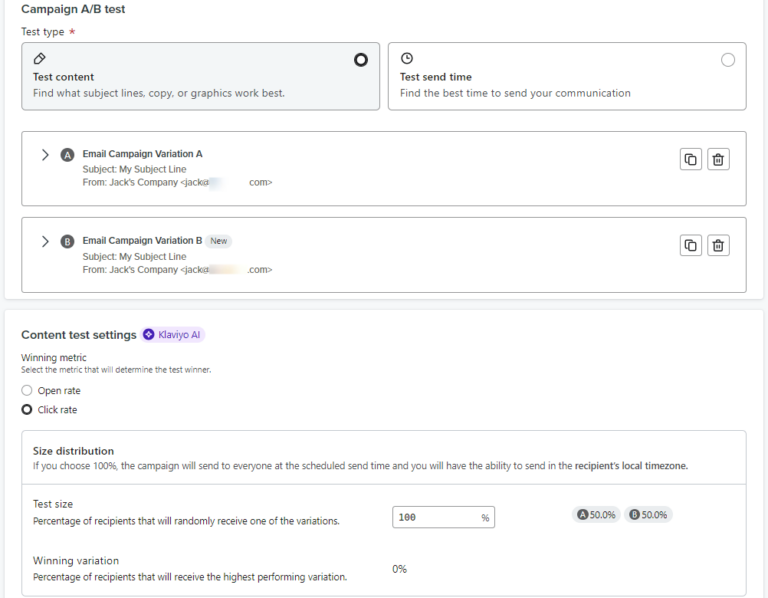
Once the test is complete, you can view the results and manually select a winner or let Klaviyo choose automatically. For larger audiences of 12,000 or more, Klaviyo offers a Smart Send Time feature that uses your historical open-email data to optimize send times automatically.
Braze takes a different approach with its Campaigns feature.
You can create campaigns for single messages or multi-channel outreach, but this feature is still meant for one-time messaging.
Braze gives you more channel options than Klaviyo. You can reach out through emails, push notifications, in-app messaging, content cards, SMS/MMS, and even WhatsApp. The key difference here is that you can choose to send your message through one channel or multiple channels within a single campaign.
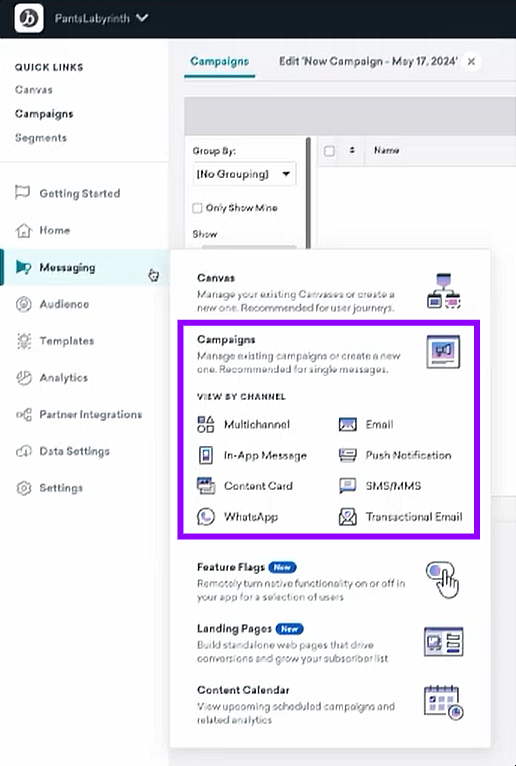
Setting up an A/B test in Braze is similar to Klaviyo.
You create a campaign, click “Add Variant,” and either copy the original or start from scratch. Then, edit your variants and schedule your multivariate campaign. For testing message timing, Braze requires you to use its Canvas feature.
When selecting your target segments, you can set aside a control group that won’t receive any test variants.
This allows you to measure not just which variant performs better, but also how your campaign performs against taking no action at all. Unlike Klaviyo, Braze doesn’t allow manual selection of a winning variant. Instead, it uses your chosen winning factor to automatically determine the best-performing version.
Wyng focuses on creating engaging on-site interactions that add to the traditional multichannel approach.
You can embed Wyng Experiences on your website and native mobile app, or publish them as standalone landing pages. While you can’t directly send these Experiences through email or SMS, you can share their links using platforms like Klaviyo and Braze. With the built-in social sharing tool, you can also get your customers to share Experiences with their friends on social media platforms like Facebook, Snapchat, WhatsApp, and more. And they can even get rewarded for it.
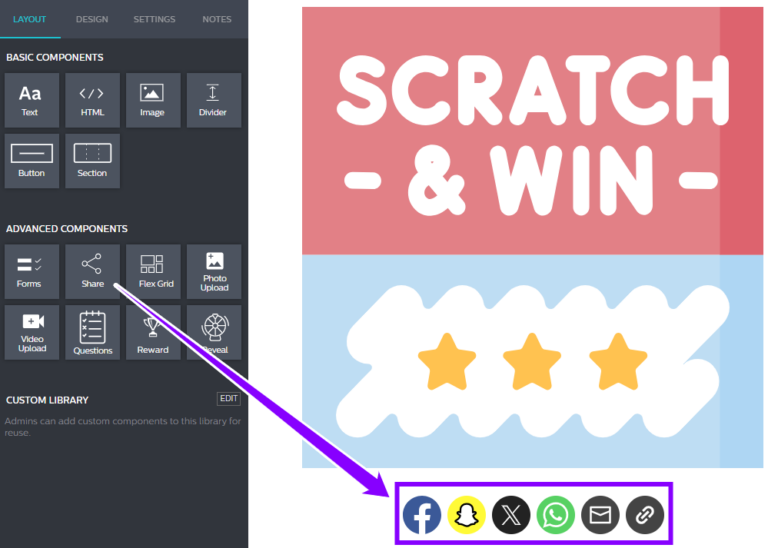
While Klaviyo and Braze excel at delivering messages across multiple channels, Wyng complements their capabilities by providing a powerful tool for on-site engagement and data collection.
Verdict: Klaviyo offers user-friendly automation with pre-built templates and an AI assistant, Braze provides detailed control over complex journeys, and Wyng complements both with on-site engagement tools. Choose based on your specific requirements for automation complexity, channel diversity, and on-site interaction capabilities.
Klaviyo vs Braze vs Wyng: Email Marketing Capabilities
Klaviyo has an intuitive email editor with tons of templates, Braze provides extensive previewing options, and Wyng naturally improves email deliverability through organic list-building and better email relevance.
| Klaviyo | Braze | Wyng |
|---|---|---|
⭐⭐⭐⭐⭐ | ⭐⭐⭐⭐ | ⭐⭐⭐ |
Email Designer: Klaviyo offers better template options, Braze provides advanced preview features, and Wyng helps make emails more relevant.
Klaviyo‘s email designer gives you three options: drag-and-drop, text-only, and HTML.
The drag-and-drop editor starts with a template library you can filter by type, layout, and season/holiday. You can also start from scratch or use your own templates. In the builder, you’ll find various block and layout elements to customize your emails. Klaviyo lets you control block visibility across devices, so you can tailor your message for different screens to ensure your emails look great on any device.
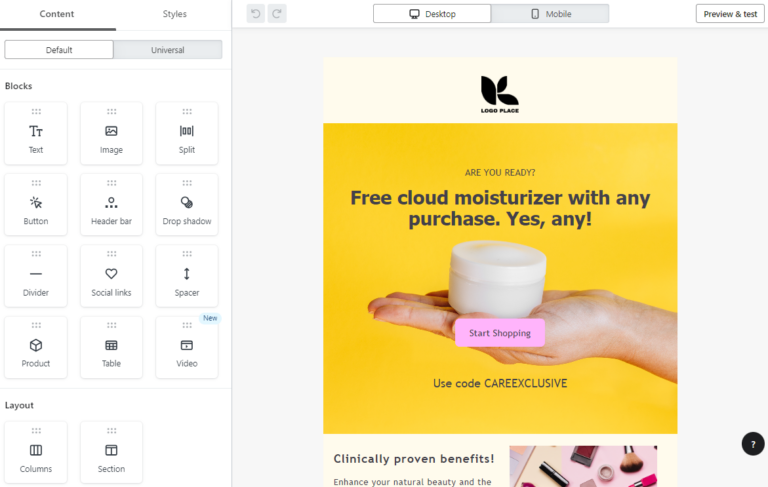
Klaviyo’s visual customization options, apart from the basic expected options, include uploading custom fonts, cropping pictures, and adding images within text via links.
When you’re done designing, you can send a test email to any address you choose to catch any issues before your campaign goes live.
Braze also offers drag-and-drop and HTML editors but with some key differences.
While you can choose from pre-built or saved templates like in Klaviyo, Braze’s block selection differs slightly. For example, you’ll find a video block in Braze, which Klaviyo doesn’t offer, while Braze lacks Klaviyo’s product and table blocks.
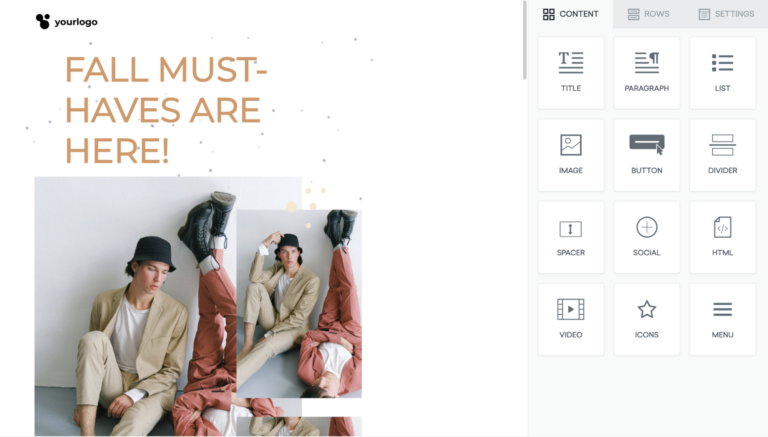
Source: Braze
Both platforms allow for global style settings or unique designs but Braze’s personalization options are more extensive than Klaviyo’s, but they’re not as intuitively laid out. You’ll need to know what you’re looking for when adding dynamic fields.
Braze stands out with its preview capabilities. You can view your email on desktop, mobile, in plaintext, and even compare dark versus light mode. You’ll know that your emails look great in all contexts.
Wyng doesn’t do email marketing, but data collected with Wyng takes center stage when you hit the “Personalize” button in Klaviyo or Braze.
Wyng improves both platforms’ ability to segment audiences and trigger highly relevant automations. You’ll be able to craft personalized customer journeys that truly speak to each individual customer.
Deliverability Features: Klaviyo offers a centralized Deliverability Hub, Braze’s Deliverability Center is more intricate, and Wyng naturally assists email deliverability.
Klaviyo’s approach to email deliverability monitoring is straightforward.
Its Deliverability Hub compiles key metrics and reports like send volume broken down by inbox provider and positive and negative engagement metrics.
If you want to dig deeper, Klaviyo lets you filter reports based on date range, message type, and message category to pinpoint specific email performance issues. However, while Klaviyo provides a comprehensive guide on improving deliverability, you’ll need to handle most of the heavy lifting yourself or integrate third-party tools like Litmus.
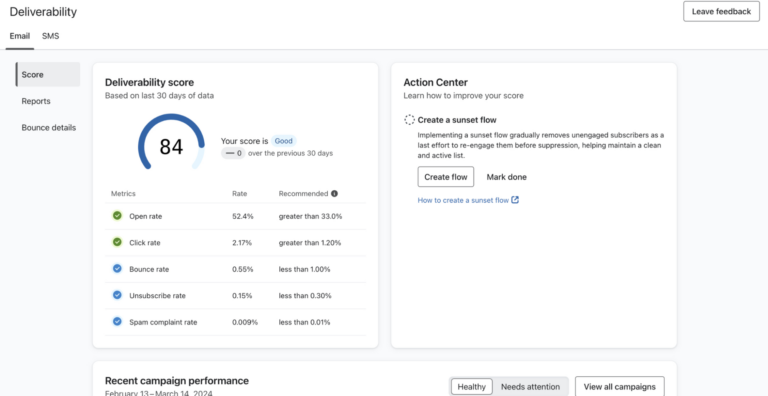
Source: Klaviyo
Braze, on the other hand, offers more robust deliverability insights through its Deliverability Center.
You can view your domains by IP Reputation or Delivery Errors, making it easier to spot and troubleshoot potential issues. Or, by connecting your Google Postmaster account to Braze, you can track data on sent emails and gather detailed information about your sending domain directly from the Braze dashboard.
Braze also provides more detailed authentication data.
You can review the percentage of emails that have passed Sender Policy Framework (SPF), Domain Keys Identified Mail (DKIM), and Domain-based Message Authentication, Reporting and Conformance (DMARC). Plus, you can see what percentage of your inbound and outbound traffic is encrypted.
If Microsoft is your primary mailbox provider, Braze also allows you to set up Microsoft Smart Network Data Services for additional deliverability insights. However, like Klaviyo, Braze doesn’t offer many built-in tools for improving deliverability.
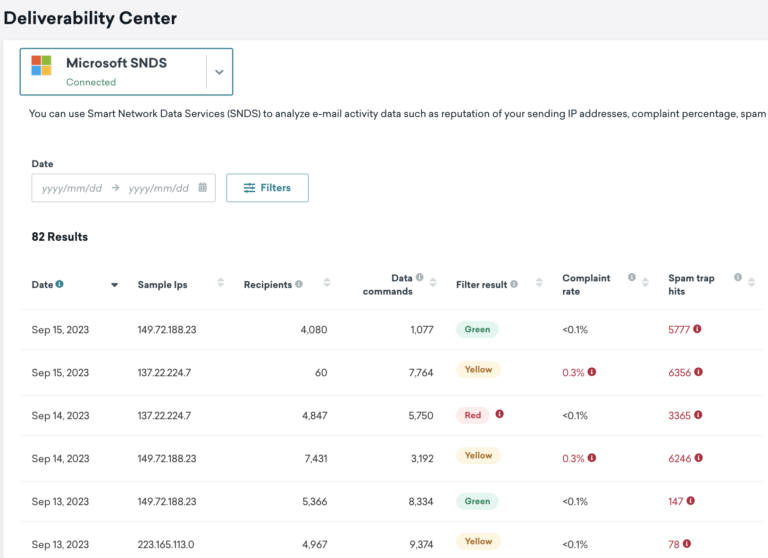
Source: Braze
Wyng naturally improves your email deliverability without extra tools. It builds your list organically, with people willingly sharing correct email addresses for rewards like coupons. And, because customers share their interests via the Wyng Experiences, you’re able to create more relevant content. Relevant emails get opened more, which also means better deliverability.
So Braze and Klaviyo offer deliverability monitoring and Wyng tackles the root cause: user interest.
Verdict: Klaviyo offers a user-friendly email editor with many templates available and a centralized Deliverability Hub. Braze provides advanced preview features and more robust deliverability insights. Wyng complements both by enhancing email relevance and naturally improving deliverability. Consider your priorities in email design complexity, deliverability monitoring needs, and if you need enhanced personalization when choosing a platform.
Klaviyo vs Braze vs Wyng: Mobile Engagement Capabilities
Klaviyo offers simple app-based push notifications and limited SMS marketing, while Braze provides diverse mobile engagement options and extensive SMS marketing coverage.
| Klaviyo | Braze | Wyng |
|---|---|---|
⭐⭐⭐⭐ | ⭐⭐⭐⭐⭐ | ⭐⭐⭐ |
SMS Marketing Tools: Klaviyo offers streamlined SMS setup and versatile features, while Braze provides extensive global coverage and flexible message creation.
Klaviyo makes setting up SMS campaigns straightforward.
The platform automatically assigns you a toll-free number for US campaigns, which you need to verify with your company info, while, for other countries, you use a branded sender ID or short/long code. This feature is available in 12 countries, including the US, UK, Australia, and several European countries. The pricing is straightforward, too – you pay 1 to 10 credits (about $0.01) per SMS or MMS, with rates varying by country.
When crafting your SMS message, Klaviyo limits you to 160 characters (or 70 with emojis). Don’t worry, though, you can still add a personal touch with personalization fields. You can include media, too, but only for specific countries and number types. And Klaviyo also supports two-way SMS chats with subscribers.
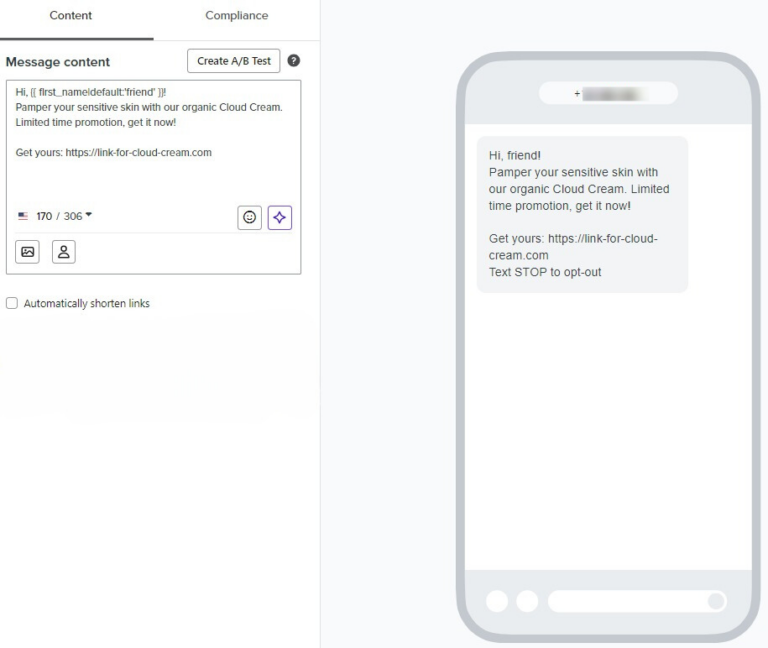
Braze takes a different approach to SMS setup; you need a dedicated phone number, but Braze handles the acquisition for you. Before you can start, you send your Braze rep a list of users with formatted phone numbers and your SMS keywords and responses.
Unlike Klaviyo’s limited coverage, Braze supports SMS features in over 200 countries — a significant advantage if you’re running global campaigns.
Braze is more generous with character limits, but they have a unique charging system based on SMS segments rather than individual messages (they provide a handy calculator to help you estimate cost). Braze also supports two-way messaging.
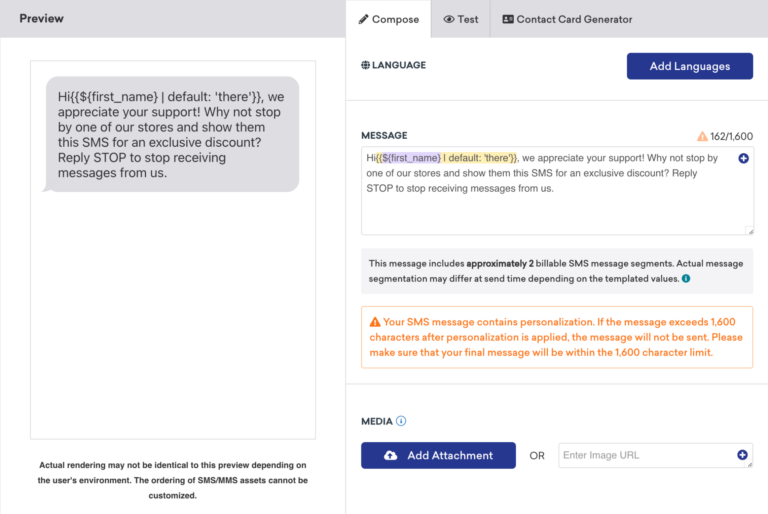
Source: Braze
Mobile App Engagement: Klaviyo focuses on app-based push notifications, while Braze offers more diverse mobile engagement options.
Klaviyo‘s mobile app engagement revolves around push notifications. However, this feature only works for customers who have downloaded your mobile app.
When crafting a push notification in Klaviyo, you can customize several elements like the message content, sound, app badge, and action when the notification is opened. You can also add static or dynamic images.
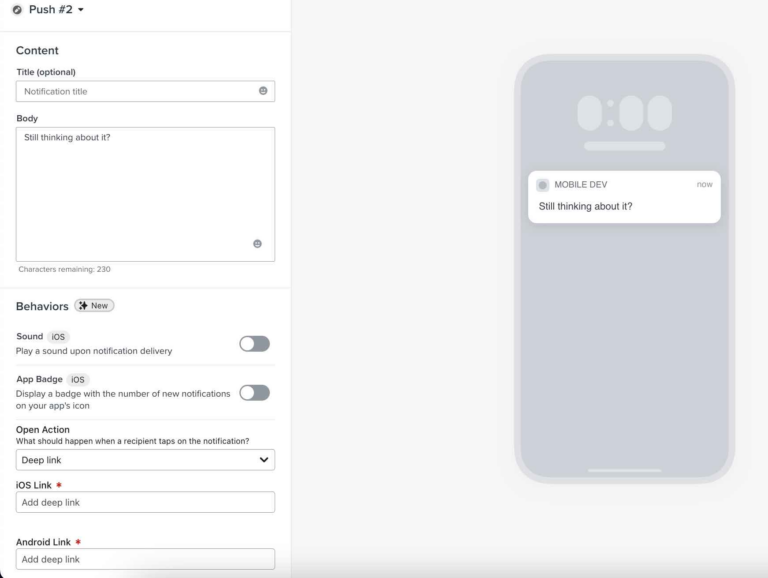
Source: Klaviyo
You have flexibility in how you send these notifications. Schedule them for later, use Smart Sending, or fire them off immediately. In Flows, push notifications can work alongside other channels, triggered by specific conditions or actions for different customer segments.
Braze takes mobile app engagement a step further by offering two main options: Push Notifications and In-App Messages.
Its Push Notifications work on both mobile devices and the web, giving you a broader reach compared to Klaviyo’s app-only approach. You can choose between three types: standard push, push stories, and inline images. You can preview how your notification will look on different devices and in various states (expanded or collapsed). Braze also supports Liquid for personalization and allows you to set up button prompts.

Source: Braze
If you’re looking for a less intrusive engagement method, Braze’s In-App Messages might be the answer. These appear within the app itself, similar to pop-ups or forms. You can create them as slide-ups, modal overlays, and fullscreen messages.
In-App Messages offer more creative freedom than Push Notifications. You can build them with various content blocks and have extensive styling options, including images, colors, and fonts.
Verdict: Klaviyo offers a streamlined SMS setup and simple push notifications, while Braze provides extensive global SMS coverage and more diverse mobile engagement options. Consider your geographic reach, desired mobile engagement features, and ease of use when choosing. Wyng complements both platforms with better data collection and personalization for mobile campaigns.
Klaviyo vs Braze vs Wyng: Analytics and Reporting
Klaviyo offers customizable dashboards, reports with scheduling, and basic predictions. Braze provides specified analytics and customizable predictive models. Wyng provides great insights into customer experience and detailed customer profiles.
| Klaviyo | Braze | Wyng |
|---|---|---|
⭐⭐⭐⭐ | ⭐⭐⭐⭐⭐ | ⭐⭐⭐⭐⭐ |
Analytics Overview: Klaviyo offers customizable dashboards and reports, Braze provides more specialized analytics tools, and Wyng tells you all about your customers’ Experiences.
Klaviyo‘s analytics are centralized in six main hubs, giving you a comprehensive view of your marketing performance — in the Analytics tab, you’ll see:
- Dashboards
- Experiments
- Metrics
- Benchmarks
- Deliverability
- Custom Reports
You can access three pre-built dashboards right off the bat: Overview, Business Review, and SMS Dashboard. These give you a quick snapshot of your multi-channel performance, including conversions, campaign results, and deliverability metrics. You can add custom cards to these dashboards or create entirely new ones tailored to your needs.
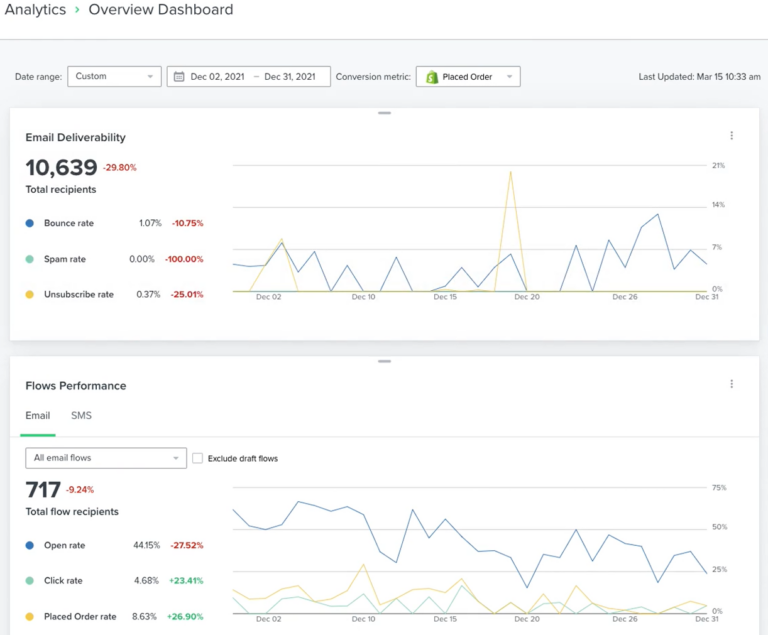
Source: Klaviyo
When it comes to custom reporting, Klaviyo’s Custom Reports feature lets you create tailored reports which you can also schedule for regular delivery. This can be a time-saver if you need to share performance data on email campaigns with your team or stakeholders regularly.
Braze organizes its analytics into Reports, Analytics Dashboard, and Predictions.
Its pre-built Dashboards are more focused on specific channels: Email Performance, SMS Performance, and Conversions. Each dashboard presents relevant metrics and visualizations, allowing you to track key performance indicators like delivery rates, open rates, and conversion funnels.
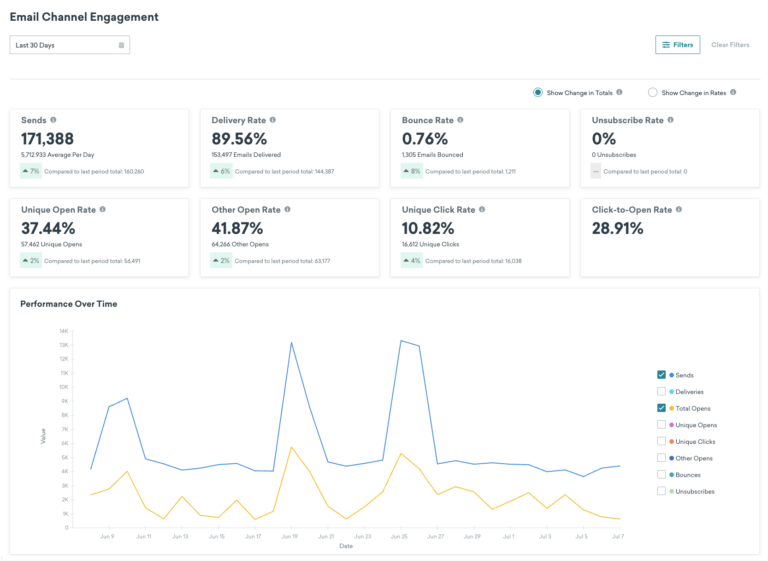
Source: Braze
With Braze’s Report Builder, you can compare results from multiple Campaigns or Canvases in a single view, making it easier to spot trends and identify top performers. The platform also provides dedicated Revenue Reports and Engagement Reports, giving you specialized insights into these critical areas of your marketing efforts.
The Wyng Metrics feature offers powerful analytics for your Experiences. It features seven dashboards with visual representations of relevant key metrics:
- Overview: At-a-glance performance indicators
- Visitors: Audience demographics and sources
- Engagement: User interaction metrics
- Forms: Submission and completion rates
- Click-Throughs: Link performance analysis
- Shares: Social sharing metrics
- Content: User-generated content engagement
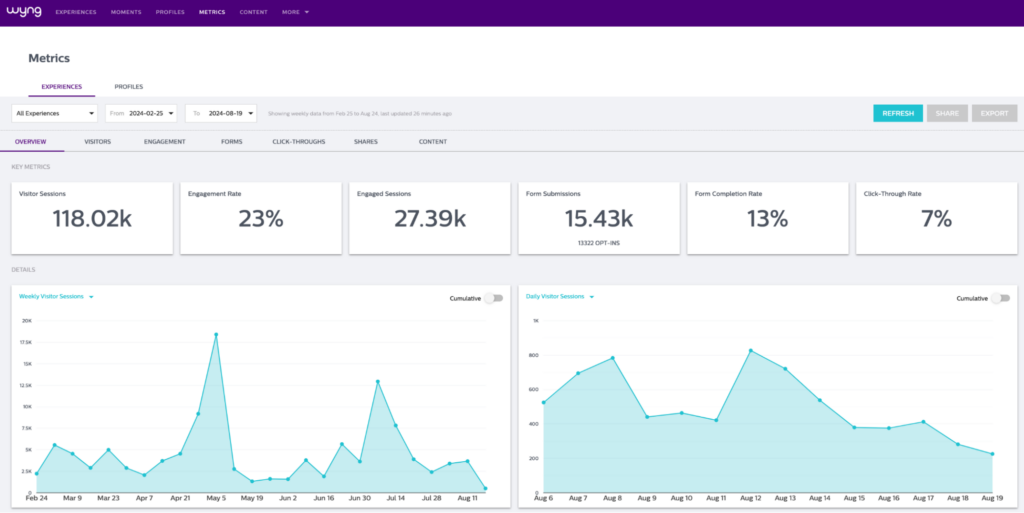
Another part of the Wyng Metrics is the Profiles Metrics, where you can review the profiles your property has collected. You’ll see top level counts of active profiles, count of total profiles, and attribute completion (what attributes are most popular among the profiles in your data set).
Predictive Analytics: Braze offers customizable predictive models, Klaviyo provides simpler out-of-the-box predictions, and Wyng helps make predictions more accurate.
Klaviyo and Braze both leverage machine learning for predictive analytics, but their approaches differ significantly in complexity and customization.
With Klaviyo, you get straightforward predictive insights without much setup. It automatically applies data science techniques to customer historical data, creating predictions for each customer profile.
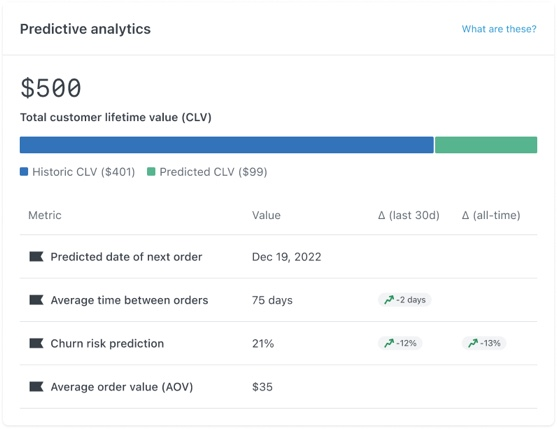
Source: Klaviyo
The predictive analytics section in each profile presents key metrics like total Customer Lifetime Value (CLV), average time between orders, churn risk, and average order value. It doesn’t show it, but Klaviyo even predicts gender to improve product recommendations. However, there’s a catch – you’ll only see these predictions if you meet certain criteria, like having at least 500 customers with orders and 180 days of order history.
Klaviyo also provides a unique prediction – the expected date of the next order – which Braze doesn’t offer.
Braze, on the other hand, puts more advanced predictive tools in your hands with its Braze Predictive Suite, powered by Sage AI. Unlike Klaviyo’s automatic predictions, Braze lets you create customizable, on-demand predictive models.
With Braze, you can build two types of predictive models: Predictive Churn and Predictive Events.
For Predictive Churn, you define what churn means for your business and select the users you want to prevent from churning. Braze then trains a machine-learning model to identify at-risk users.
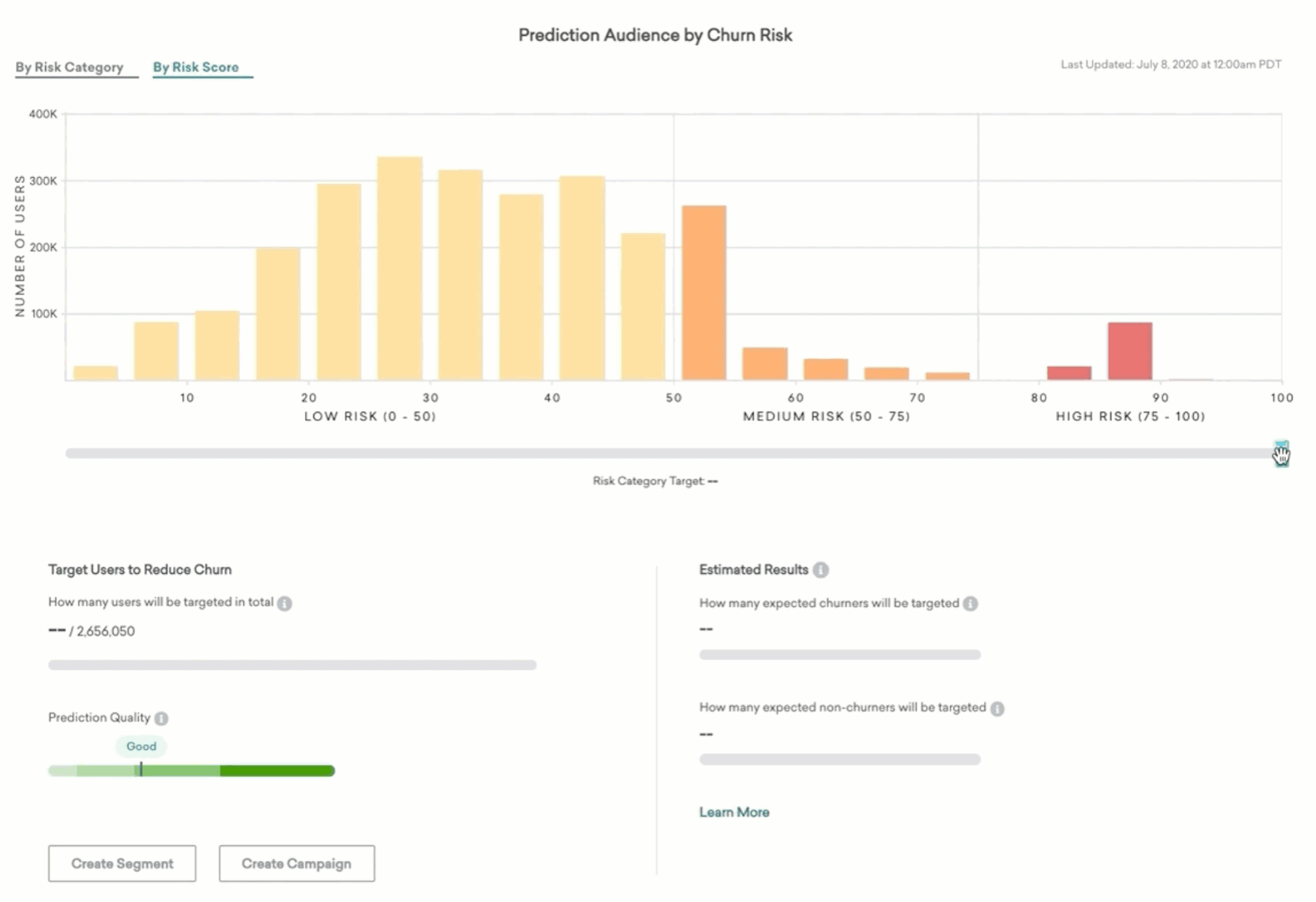
Source: Braze
Once you’ve built and trained a prediction in Braze, you get access to a detailed Prediction Analytics page. This shows you the distribution of churn scores, prediction quality, and estimated results for targeting specific audience segments.
Braze’s Predictive Events feature is similar but focuses on the likelihood of users performing specific events, like making a purchase. After building a model, users are assigned likelihood scores between 0 and 100.
While Wyng doesn’t offer predictive features itself, the data it collects is invaluable for anticipating consumer behavior. Want to know if a customer will engage with a new product line? Wyng lets you ask the right questions to tailor your approach proactively. This additional layer of declared data leads to more meaningful performance metrics and more accurate predictions when integrated with Klaviyo or Braze’s machine learning models.
Verdict: Klaviyo offers customizable analytics, reports that can be scheduled, and simple predictive insights. Meanwhile, Braze offers more specialized analytics tools and advanced, customizable predictive models. Wyng provides detailed Experience analytics and intricate customer profiles. By enriching customer data it helps out Klaviyo and Braze in making more accurate predictions. Consider your need for analytics tools, predictive modeling capabilities, and in-depth customer experience insights when choosing a platform.
Klaviyo vs Braze vs Wyng: Pros & Cons
 | |
Klaviyo Pros | Klaviyo Cons |
| ✅ Straightforward Email and SMS campaigns setup | ❌ Limited form and landing page functionality |
| ✅ Intuitive automation building | ❌ Limited marketing channels |
| ✅ Good CDP with AI-assisted segmentation | ❌ Basic predictive analytics with less customization options |
| ✅ Easy monitoring with the Deliverability Hub | ❌ SMS marketing restricted to 12 countries |
| ✅ Customizable analytics dashboards | |
 | |
Braze Pros | Braze Cons |
| ✅ Multi-channel campaigns | ❌ Complex setup and learning curve |
| ✅ Flexible segmentation and personalization | ❌ Limited form-building capabilities |
| ✅ Complex journey control with Canvas | ❌ Pricing not public |
| ✅ Extensive SMS coverage (200+ countries) | ❌ Data platform and landing pages in the works |
| ✅ Customizable, on-demand predictive models | |
 | |
Wyng Pros | Wyng Cons |
| ✅ Advanced audience engagement and interactive experiences | ❌ Not a standalone multi-channel marketing automation platform |
| ✅ Exceptional form builder and landing page functionality | |
| ✅ Specialized in zero-party data collection and utilization | |
| ✅ Powerful analytics for customer experiences and unified profiles | |
| ✅ Complements other platforms with advanced segmentation capabilities | |
Final Verdict: Braze vs Klaviyo vs Wyng
Businesses that value simplicity will like Klaviyo, large enterprises with complex needs will like Braze, and those seeking advanced customer engagement and understanding will benefit from Wyng.
| Klaviyo | Braze | Wyng |
|---|---|---|
Best for: | Best for: | Best for: |
These three tools cater to different business needs and stages of growth: Klaviyo is ideal for businesses of all sizes looking for straightforward yet powerful marketing automation, Braze serves large enterprises with complex multi-channel needs, and Wyng enhances both platforms with advanced audience engagement, zero-party data collection, and precise segmentation capabilities.
Use Klaviyo if:
- You want user-friendly marketing automation with AI-assisted features.
- You need a straightforward email marketing platform with good deliverability features.
- You’re looking for simple predictive analytics out-of-the-box.
Click here to get started with Klaviyo!
Use Braze if:
- You’re a large enterprise with complex, multi-channel marketing needs.
- You require advanced mobile engagement features, including global SMS coverage.
- You want customizable, on-demand predictive models for your marketing efforts.
Click here to get started with Braze!
Use Wyng if:
- You need advanced audience engagement tools and interactive experiences.
- You want to enhance your martech stack with superior data collection.
- You want to create highly personalized customer experiences and precise audience segments.
Click here to get started with Wyng!
Learn how Wyng stacks up against other interactive experience platforms like ShortStack and Wishpond — get a full picture of ShortStack vs Wishpond vs Wyng here!
